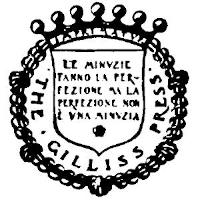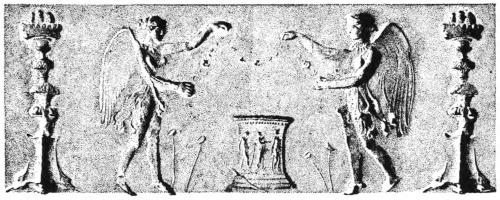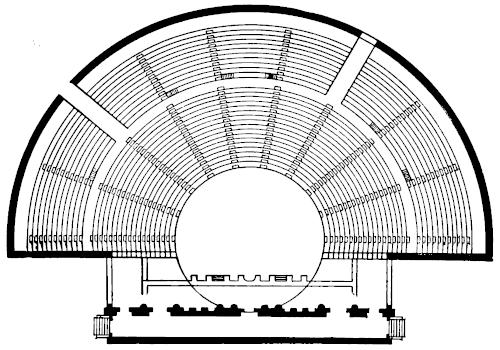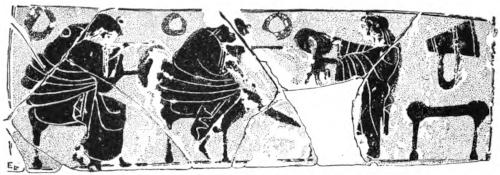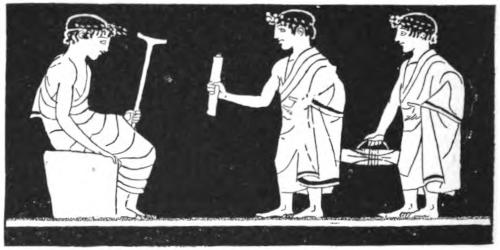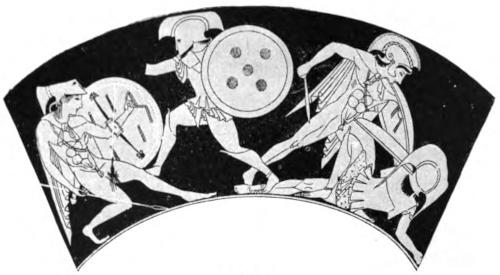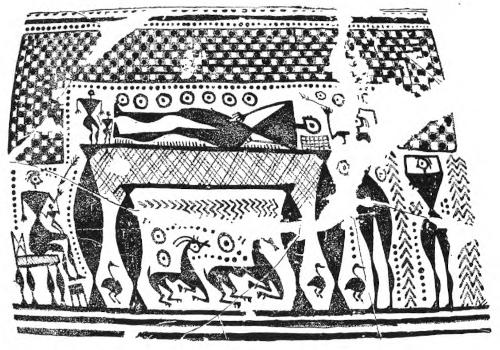.
THE DAILY LIFE OF
THE GREEKS AND ROMANS

THE METROPOLITAN MUSEUM
OF ART
THE DAILY LIFE OF THE
GREEKS AND ROMANS
AS ILLUSTRATED IN
THE CLASSICAL COLLECTIONS
BY
HELEN McCLEES, Ph. D.

NEW YORK
MCMXXIV
COPYRIGHT
BY THE METROPOLITAN MUSEUM
OF ART, 1924
| PAGE | ||
| Illustrations | vii | |
| Introduction | xiii | |
| The Daily Life of the Greeks and Romans | ||
| I. | Religion | 3 |
| II. | The Drama | 13 |
| III. | Houses and Furniture | 19 |
| IV. | Occupations of Women | 32 |
| V. | Children and Education | 40 |
| VI. | Dress and Toilet | 47 |
| VII. | Amusements, Music, and Dancing | 68 |
| VIII. | Arms and Armor | 76 |
| IX. | Athletics | 89 |
| X. | Races and Riding | 98 |
| XI. | Gladiators | 106 |
| XII. | Trades and Crafts | 109 |
| XIII. | Burial-Customs | 121 |
| PAGE | ||
| Cover Design: Adaptation of wall-painting in cubiculum from Boscoreale. Eighth Room. | ||
| Vignette on Title-page: Departure of a warrior, from a lekythos. Case G, Fifth Room. | ||
| Introduction | ||
| Head-band: Design from a Roman table in the cubiculum. Eighth Room | xv | |
| Tail-piece: Oscillum. Case 1 | xvii | |
| Chapter I | ||
| Head-band: Genii sacrificing, from an Arretine bowl. Case G, Eighth Room | 3 | |
| 1. | Praying youth (?) | 4 |
| 2. | Man saluting a statue of Athena | 5 |
| 3. | Man carrying a pig to be sacrificed | 3 |
| 4. | Votive table | 6 |
| 5. | Votive plaque | 6 |
| 6. | Terracotta herm | 7 |
| 7. | Warriors making a treaty (?) | 7 |
| 8. | Charms of colored glass | 7 |
| 9. | Lar | 8 |
| 10. | Roman priest | 9 |
| 11. | Camillus | 10[viii] |
| 12. | Statue of Cybele on its car | 11 |
| 13. | Sacrificial procession | 11 |
| 14. | Sistrum | 12 |
| Chapter II | ||
| Head-band: Plan of the theatre of Segesta, Redrawn from Laloux, L’Architecture grecque, p. 233, fig. 217 | 13 | |
| 15. | Tragic mask | 14 |
| 16. | Slave in Old Comedy | 14 |
| 17. | Theatre at Epidaurus | 15 |
| 18. | Actor of mimes | 16 |
| 19. | Actor in New Comedy | 17 |
| 20. | Comic actor as Herakles | 17 |
| Tail-piece: Terracotta mask of a Satyr. Case 1 | 18 | |
| Chapter III | ||
| Head-band: House of Sallust, redrawn from Mau-Kelsey, Pompeii, published by the Macmillan Company, p. 287, fig. 136 | 19 | |
| 21. | Roman wall-painting | 20 |
| 22. | Cubiculum | 21 |
| 23. | Mosaic picture | 22 |
| 24. | Old man seated on a klismos | 23 |
| 25. | Bronze cauldron | 24 |
| 26. | Greek table-ware of painted terracotta | 25 |
| 27. | Bronze patera | 26 |
| 28. | Bronze wine-jug | 27 |
| 29. | Bronze jug | 27 |
| 30. | Bronze beaker | 27 |
| 31. | Bronze ladle for wine | 28 |
| 32. | Bronze wine-strainer | 28[ix] |
| 33. | Roman silver cup | 29 |
| 34. | Roman silver spoons | 29 |
| 35. | Bronze candelabrum | 30 |
| 36. | Bronze lamp on a stand | 31 |
| Tail-piece: Campanian plate for fish. Case Q, Sixth Room | 31 | |
| Chapter IV | ||
| Head-band: Women working wool, from an epinetron. Case 2 | 32 | |
| 37. | Woman embroidering or making a net | 32 |
| 38. | Onos or epinetron | 33 |
| 39. | Woman carding wool | 33 |
| 40. | Embroidered clothing | 34 |
| 41. | Greek country-woman spinning | 35 |
| 42. | Baking bread in a primitive oven | 36 |
| 43. | Women winnowing and grinding corn | 36 |
| 44. | Women at a well-house in Athens | 37 |
| 45. | Marriage-vase | 38 |
| Tail-piece: Woman spinning, from a pyxis. Case A, Fourth Room | 39 | |
| Chapter V | ||
| Head-band: Boys going to school, from a kylix. Case 3 | 40 | |
| 46. | Gold bulla | 40 |
| 47. | Old nurse holding a baby | 41 |
| 48. | Terracotta feeding bottle | 41 |
| 49. | Toy horse on wheels | 42 |
| 50. | Tomb lekythos. Child drawing a cart | 42 |
| 51. | Girls playing ball | 43 |
| 52. | Boy rolling a hoop | 43 |
| 53. | Women whipping tops | 44[x] |
| 54. | Stylus | 44 |
| 55. | Ephedrismos game | 45 |
| 56. | Boy with a writing tablet | 45 |
| 57. | Ink-pot | 46 |
| Tail-piece: Jointed terracotta doll. Case 3 | 46 | |
| Chapter VI | ||
| Head-band: Fibula. Gold Room | 47 | |
| 58. | Diagram of Doric chiton, reproduced from British Museum, A Guide to the Exhibition illustrating Greek and Roman Life, 2d edition, fig. 129 | 47 |
| 59. | Amazons in Men’s Ionic chitons, reproduced from Furtwängler und Reichhold, Griechische Vasenmalerei, I, pl. 82 | 48 |
| 60. | Early chitons | 49 |
| 61. | Woman’s Doric chiton of the fifth century | 50 |
| 62. | Woman in Ionic chiton | 51 |
| 63. | Doric chiton without girdle | 52 |
| 64. | Terracotta statuette. Lady in himation and hat | 53 |
| 65. | Terracotta statuette. Lady in himation | 53 |
| 66. | Terracotta statuette. Man in riding-cloak and hat | 53 |
| 67. | Man’s chiton | 54 |
| 68. | Akropolis maiden in Ionic chiton and himation | 55 |
| 69. | Greek sandal | 56 |
| 70. | Greek jewelry | 57 |
| 71. | Women’s coiffures, reproduced from Abrahams, Greek Dress, fig. 45 | 58 |
| 72. | Strigil | 59[xi] |
| 73. | Razor | 60 |
| 74. | Alabastron | 60 |
| 75. | Aryballos | 61 |
| 76. | Glass bottle | 61 |
| 77. | Silver pyxis | 62 |
| 78. | Terracotta pyxis | 62 |
| 79. | Spatula | 63 |
| 80. | Dipping-rod | 63 |
| 81. | Greek mirror on a stand | 64 |
| 82. | Etruscan mirror | 65 |
| 83. | Greek mirror and cover | 65 |
| Tail-piece: Dionysos wearing the himation, from a krater. Case J, Fourth Room | 67 | |
| Chapter VII | ||
| Head-band: Symposium, from a krater. Case X, Fourth Room | 68 | |
| 84. | Symposium, reproduced from Furtwängler und Reichhold, I, pl. 73. | 69 |
| 85. | Kottabos-stand | 70 |
| 86. | Glass astragals | 71 |
| 87. | Girls playing with astragals | 71 |
| 88. | Youth with a lyre | 72 |
| 89. | Girl dancing and playing the castanets | 72 |
| 90. | Apollo with a kithara | 73 |
| 91. | Terracotta figurine. Woman dancing | 74 |
| 92. | Terracotta figurine. Woman dancing | 75 |
| Tail-piece: Girl dancing, from a kylix. Case G, Fifth Room | 75 | |
| Chapter VIII | ||
| Head-band: Combat, from a kylix. Case K, Fourth Room | 76[xii] | |
| 93. | Greek foot-soldier, reproduced from Die Bronzen aus Dodona, pl. 11 | 76 |
| 94. | Italic helmet | 77 |
| 95. | Italic helmet with metal crest | 77 |
| 96. | Cap-shaped helmet | 77 |
| 97. | “Jockey-cap” helmet | 77 |
| 98. | Corinthian helmet | 77 |
| 99. | Italic armored belt | 78 |
| 100. | Pair of greaves | 78 |
| 101. | Italic cuirass | 79 |
| 102. | Greek cuirass of the fifth century | 80 |
| 103. | Warrior carrying a shield | 81 |
| 104. | Persian fighting with a machaira | 82 |
| 105. | Javelin-head | 83 |
| 106. | Spear-head | 83 |
| 107. | Dagger-blade with hooked tang | 83 |
| 108. | Leaf-shaped dagger-blade | 83 |
| 109. | Bronze sword | 83 |
| 110. | Arrow-heads | 84 |
| 111. | Amazon with battle-axe and wicker shield | 85 |
| 112. | Lamp. Victory with a trophy | 87 |
| Tail-piece: Attic helmet. Case 4 | 88 | |
| Chapter IX | ||
| Head-band: Pankratiasts, from a skyphos. Case 4 | 89 | |
| 113. | Jumper with halteres | 90 |
| 114. | Diskos-thrower | 91 |
| 115. | Athlete throwing a javelin | 92 |
| 116. | Wrestlers | 92 |
| 117. | Scene from the pankration | 93 |
| 118. | Panathenaic amphora | 94 |
| 119. | Youth binding on a fillet | 95 |
| Tail-piece: Votive disk, redrawn from Jüthner, Die antiken Turngeräthe, p. 27, fig. 20 | 97[xiii] | |
| Chapter X | ||
| Head-band: Horsemen, from a krater. Case X, Fourth Room | 98 | |
| 120. | Bronze chariot | 99 |
| 121. | Racing cars on Syracusan coins | 100 |
| 122. | Lamp. Scene from the circus | 100 |
| 123. | Panathenaic amphora. Chariot race | 100 |
| 124. | Bit used in training horses | 102 |
| 125. | Horse’s muzzle | 102 |
| 126. | Young horseman | 103 |
| 127. | Bronze bit | 104 |
| Tail-piece: Horseman, bronze statuette. Case B, Third Room | 105 | |
| Chapter XI | ||
| Head-band: Gladiatorial combats, from a glass cup. Case 3 | 106 | |
| 128. | Samnite gladiator | 107 |
| 129. | Thracian gladiator | 107 |
| Tail-piece: Hoplomachus, from a terracotta lamp. Case 5 | 108 | |
| Chapter XII | ||
| Head-band: Roman steelyard. Case 1 | 109 | |
| 130. | Bronze farmyard group | 110 |
| 131. | Greek farmer ploughing | 111 |
| 132. | Terracotta model of a cart | 112 |
| 133. | Terracotta from Cyprus. Donkey with panniers | 112 |
| 134. | Donkeys carrying jars in panniers, 1922 | 113[xiv] |
| 135. | Key. Early type | 114 |
| 136. | Lock-plate | 114 |
| 137. | Key. Later type | 114 |
| 138. | War-vessels. Vase painting | 115 |
| 139. | Terracotta boat | 115 |
| 140. | Gold-beater’s block | 116 |
| 141. | Unfinished pottery cup | 117 |
| 142. | Ancient mould and modern relief | 117 |
| 143. | Dikast’s ticket | 118 |
| 144. | Forked probe | 119 |
| 145. | Spatulae | 119 |
| Tail-piece: Terracotta goat. Case B2, Third Room | 120 | |
| Chapter XIII | ||
| Head-band: Funeral scene from a dipylon vase. Case L, Second Room | 121 | |
| 146. | Mourners at a bier. Terracotta relief | 122 |
| 147. | Poet on his bier (?). Terracotta plate | 122 |
| 148. | Dipylon vase | 123 |
| 149. | Athenian tomb lekythoi | 124 |
| 150. | Marble lekythos | 125 |
| 151. | Etruscan focolare | 126 |
| 152. | Monument of Sostrate | 127 |
| 153. | Etruscan urn for ashes | 128 |
| 154. | Etruscan urn | 129 |
| 155. | Etruscan urn | 129 |
| 156. | Roman grave monument | 130 |
| Tail-piece: Akroterion, Sculpture Gallery, No. 5A | 131 | |
This handbook is intended to serve as a guide to those objects in the Classical Collection which illustrate the daily life of the Greeks and Romans. Some of these have been brought together as a special exhibition in Cases 1 to 5 in the Fifth Room, while others which it has not been possible to move are referred to in their respective positions. Many of these antiquities are among the most valued possessions of the Museum, while others are entirely lacking in artistic qualities and would scarcely attract the visitor’s attention, yet placed in their proper relations they are found to be full of unsuspected interest.
Investigations of the sites of ancient cities, settlements, and burial places, especially during the last fifty years, have brought to light objects of the most varied kinds which allow us to know, as was never before possible, the appearance and manner of life, the tools, utensils, weapons, and toys of the Greeks and Romans. Any one who will take up an old translation of an author such as the elder Pliny, Xenophon, or Martial, and compare it with a modern version will see at once the difference in this particular. The earlier translator was often at a loss when confronted with allusions to every-day life and consequently either did not express clearly the meaning of his original or even entirely misrepresented it. But quite[xvi] apart from a correct interpretation of the works of ancient writers, the study of private antiquities enables us to form a mental picture of these people and their surroundings, the actors in the theatre, the citizens gathered in the assembly or at a religious festival, the houses from which they came, and the work they left behind; and as a result, to see the world with their eyes, to comprehend their aims and actions, and to compare them more intelligently with our own.
The greater part of these objects were not very valuable at the time they were made; they were the ordinary possessions of ordinary persons. Yet one sees on all sides evidence of the skill, careful workmanship, and artistic feeling ungrudgingly spent in making simple, common articles for every-day use. In our own time the situation is very different; to the average person beauty and utility have little or no relation to each other, and he consequently provides for his home useful and necessary utensils which have no beauty, and so far as he is able adds “ornaments” which have no utility and very frequently, it must be said, no real beauty. Again, the period in which we are living has not produced any definite style, either in architecture or in the arts and crafts, though there has been much careful copying and adapting of earlier ideas; but the products of Greek and Roman artists and craftsmen have “style,” not as a result of striving for an effect, but because each workman received the traditional schooling in his craft and, having practised it with satisfaction in work well done, tried to add something to the store of knowledge before handing it on to the next generation. Such considerations alone would make the study of the every-day utensils of classical times a valuable one in the present day.
No attempt has been made in this handbook to treat the subject exhaustively; it is intended merely to provide such[xvii] explanation and commentary as will be helpful toward an understanding of the antiquities. In consequence the length of the sections has been determined by the amount of material available and does not necessarily correspond to the relative importance of the various subjects.
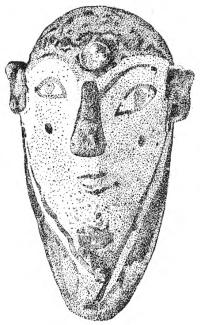
The religion of the Greek and Roman peoples was composed of many elements, and presents throughout their history a great variety of cults and observances. Religious tenets were not defined, and no priestly hierarchy attempted to coerce the people in their beliefs or actions. A Greek or a Roman was not under the necessity of worshipping the gods, though he might incur the anger of his fellow-citizens by outraging their feelings. To the ordinary man or woman, however, the service of the gods was a daily duty and each important event of human life had its appropriate observance. The head of every family was its priest, and the children his assistants in carrying out the worship of the divine beings who guarded the house and fields and all the living creatures therein. Similarly the great gods of the city were served by the priests and priestesses appointed to represent the city, conceived of as one great family. Each city had its recurring festivals, its rest days sacredly kept, and its days of commemoration of the dead.
Public worship in Greece and Italy consisted of prayers and hymns, and of sacrifices offered both within the temples and shrines and in other places, such as groves and springs, which were held to be sacred. The temples were built and adorned with all possible care, and were the pride of the community. An amphora (on the bottom of Case S in the Fourth Room) decorated with a religious scene shows a common type of altar. It is shaped rather like a pedestal with an architectural moulding and “horns” on either side. A miniature terracotta shrine from Cyprus (on the right side of the top shelf in Case 1), made for household use, gives us an idea of the shape of the larger ones which held a statue at crossroads and street corners. Incense, a frequent accompaniment of worship, was burned in a covered vessel, often provided with a high stand, such as the incense burner painted on a small oinochoë in Case G in the Fifth Room; or a little altar was used for the purpose. An example from Cyprus, which still shows traces of fire, stands on the top shelf of Case 1. A marble lamp from a temple is in Case G in the Third Room. It was made to be set in a support, probably a bronze tripod, and was filled with oil in which a wick floated.

FIG. 1. PRAYING YOUTH (?)
In prayer the worshipper looked upward and raised both hands. This attitude is perhaps represented in a bronze statuette, probably a votive offering, in Case D in the Fifth Room (fig. 1). A small wine-jug (Case 1, middle shelf) is decorated with a scene no doubt very common in Athens;[5] before a statue of Athena raised on a low column stands a man saluting the goddess by kissing his fingers and raising them toward her (fig. 2). A bronze votive statuette in Case D in the Fourth Room is making the same gesture.

FIG. 2. MAN SALUTING A STATUE OF ATHENA

FIG. 3. MAN CARRYING A PIG TO BE SACRIFICED

FIG. 4. VOTIVE TABLE

FIG. 5. VOTIVE PLAQUE
The universal custom of offering to a divinity gifts in supplication and thanksgiving has many interesting illustrations in the collection. A remnant of the ancient religion of Crete is the die for moulding miniature bronze axes in Case B in the First Room. The little bronze figure of a man carrying a pig in Case C2 in the Third Room served as a memorial of a burnt sacrifice (fig. 3). The terracotta warriors from Cyprus (Case 1 and the wall-cases in the corridor), and the Italic bronze warriors (Case 3 and Case J in the Third Room) were probably thank-offerings for a victorious home-coming. The group of terracotta figures holding one another’s hands gives a rude picture of a ring-dance such as was[6] performed in honor of Aphrodite in Cyprus (Case 1, top shelf). The painted terracotta face above this shelf is an example of the many little masks called “oscilla” which were hung by cords in sanctuaries or on the branches of trees outside (see tail-piece, p. xvii). They seem to have been a substitute for the worshipper when he was obliged to be away about his daily occupation. Several other examples will be found in wall-cases in the corridor. Fourteen miniature bronze greaves in Case 4 were probably dedications, perhaps made by soldiers after a battle. Food and drink were the simplest and commonest gifts, but were often beyond the means of the worshipper. If this were true, he gave a representation in some cheap material of the offering he wished to make, thus expressing pressing his good-will. In Case 1 are three little tables with articles of food in relief upon the surface. We see a ham, a whole boar, some cakes, fruit, and various dishes of food (fig. 4). Near these tables is a little tray with several cakes represented in relief upon it, a substitute for the cakes which were placed on tables in the temples, like the shew-bread of the Hebrews. The group of vases connected by a ring was used for offering small portions of liquid, probably oil, wine, honey, or milk. Gratitude for the cure of disease was often exhibited by dedicating a representation of the affected part. On the top shelf at the left are terracotta plaques showing eyes, eyes and mouth, and an ear (fig. 5). Other examples are[7] in Cases 47 and 75 in the Cesnola Collection. The manufacture and sale of such objects formed an industry in ancient times, and the records of the temple of Asklepios at Athens which are still preserved contain long lists of them.

FIG. 6. TERRACOTTA HERM

FIG. 7. WARRIORS MAKING A TREATY (?)

FIG. 8. CHARMS OF COLORED GLASS
The ceremonies and sacrifices in temples were few compared to the frequent occasions for private and family worship. No meal was eaten without offering a portion of food and drink to the gods, and statuettes and symbols of divinities were kept in various rooms of the house and near the house-door. The rude bust of Hermes on a pillar (Case 1, middle shelf) is of the same type as the much larger pillars which in Athens were placed near[8] house-doors, in schools, and in the market-place (fig. 6). It was the mutilation of these images which caused such consternation immediately before the sailing of Nikias on the disastrous Sicilian expedition in 415 B.C.

FIG 9. LAR
An interesting terracotta relief in Case 4 represents two warriors clasping hands (fig. 7). Perhaps it may be regarded as a votive offering made to commemorate a treaty or an alliance, either of which with the Greeks and also the Romans was an agreement made in the sight of the gods and accompanied by sacrifices. Readers of the Anabasis will remember the treaty made by the Greeks and the Persians after Cyrus’s death (II, ii, 8, 9), when the sword-blades and spear-heads were dipped in the blood of the victims caught in a shield, and the leaders on both sides gave their right hands as a pledge of fidelity.
The superstitious and fearful aspect of ancient religion is represented by the grotesque faces called apotropaia, “turners away,” which were thought to avert misfortune. They were worn especially by children, and large ones of various materials were often fastened up in workshops and houses. A number of small examples in glass are in Case C in the Third Room (fig. 8).
Perhaps the first divinities we think of when we turn to[9] the native Roman religion are the Lares, the guardians of house and field. The Lar was represented as a youth holding a horn of plenty and a patera, a shallow bowl used in sacrificing (fig. 9). Two of these figures stood side by side near the hearth in the principal room of the early Roman house, but at a later period they were placed in a little shrine usually adjoining the atrium. A statuette of rather careless workmanship stands on the middle shelf in Case 1 and a much better example in Case J in the Eighth Room. A fine statuette of the Imperial period represents a priest with his toga drawn up over his head in preparation for sacrificing, in accordance with the custom which Virgil mentions in the Aeneid: “Veil thine hair with a purple garment for covering, that no hostile face at thy divine worship may meet thee amid the holy fires and make void the omens” (III, vv. 405ff. Mackail) (Case J in the Eighth Room, fig. 10). A life-size statue of a camillus, a boy assistant at religious rites, is in this room (fig. 11). The office of camillus was an honorable one bestowed upon the young sons of distinguished families.

FIG. 10. ROMAN PRIEST
We have several interesting objects related to special cults. A goddess revered by both Greeks and Romans was Tyche or Fortuna. A small bronze statuette (Seventh Room, Case H 2) represents the Fortune of Antioch seated on a rock, crowned with turrets, and holding in her hand a sheaf of grain. Fortuna had many temples in Rome, where she was worshipped under different titles. The[10] popular belief in her power is attested by Caesar, who tells of the confidence felt by his men in him and in his success because they believed him to be a favorite of Fortune. A rather rude statuette of this divinity stands on the second shelf of Case 1.

FIG. 11. CAMILLUS
The worship of the Egyptian goddess Isis gradually spread from Egypt into Asia Minor and thence into Greece and Rome. The bronze sistrum or rattle was used in her rites, and she is often represented holding it in her hand (Case 1, fig. 14).
An especially interesting memorial of an Eastern cult established in Rome is the statuette of Cybele, the Mother of the Gods, on her processional car drawn by lions (Case M in the Eighth Room, fig. 12). The worship of Cybele, a[11] very ancient one, was introduced into Rome during the Second Punic War at a time of great danger and anxiety. Our statuette represents not the goddess herself but her cult statue, and probably commemorates one of the annual festivals at which the image on its car was taken to the river Almo to receive a ritual bath. The god-companion of Cybele, Attis, was not worshipped at Rome before the time of Claudius, though his cult was diffused over many parts of the East. A little terracotta from Cyprus shows him in Phrygian dress on a horse (Case 1).

FIG. 12. STATUE OF CYBELE ON ITS CAR

FIG. 13. SACRIFICIAL PROCESSION
A glass relief (on the tray above the middle shelf) gives a[12] realistic picture of a Roman sacrifice (fig. 13); an ox is being led through the portico of a temple by four men carrying knives and an axe. A priestess walks before them with veiled head, holding a box containing incense, meal, or other articles used at sacrifices.

FIG. 14. SISTRUM
Dramatic performances in Greece were a part of the worship of the wine-god Dionysos, and in consequence attendance in the theatre at Athens was a religious duty as well as a pleasure. The audience was composed of the citizens, both men and women, and visitors from other states and cities. In early times the playwright acted in his own play, but later the profession of actor was distinct from that of poet. Women’s parts were taken by men.
Plays were performed by daylight in the open air, in theatres so constructed that most of the audience was at a considerable distance from the actors. These circumstances naturally had a great effect upon the conventions of the theatre and the manner of acting, as effects must be broad, characters must be typical rather than individual, and facial play was impossible (fig. 17). Early in the[14] history of the Greek drama masks for the actors were introduced, and continued in use for both tragedy and comedy. They were usually made of linen stiffened with clay and painted, though cork and wood were also used. The pupils of the eyes were perforated so that the actor could see, and the mouth was always open. In Case 1 are two terracotta masks, possibly made for use, one of a satyr (see tail-piece, p. 18), the other of a young woman, and two little masks representing comic characters. In the same room above Case 4 is a large tragic mask of marble (fig. 15). This fine piece of decorative work is modeled after the masks worn by the heroes of the tragic stage. Above the tragic mask rose a projection called onkos which increased the apparent height of the wearer. For the same purpose a shoe with a very thick sole, the kothornos, was worn; the height of onkos and kothornos varying with the importance of the character. The dress of the tragic actor corresponded in a general way with that of every-day life, but the chiton was long, and the costumes were frequently bright in color and decorated elaborately with woven or embroidered bands.

FIG. 15. TRAGIC MASK

FIG. 16. SLAVE IN OLD COMEDY

FIG. 17. THEATRE AT EPIDAURUS

FIG. 18. ACTOR OF MIMES
A group of terracotta statuettes from Athens (Sixth Room, Case L) gives a vivid picture of the actors of the Old Comedy, that of Aristophanes and his contemporaries. By a convention of the stage, all comic actors, even those who played young women’s parts, were grotesquely padded, and over the padding male characters wore an elastic woolen covering much like the modern jersey, which is represented by dots in the statuettes. The man’s chiton was always ridiculously short. Women wore the long chiton and himation. On examining these figures we see that they include certain stock characters which were used over and over by playwrights. The figure on the left hand in the lowest row represents an old man, probably an irascible old father. His mask is made so as to present a kindly expression on one side and an angry one on the other. The actor turned to the audience the side which expressed his feelings at the moment. The statuette at the left of the top row seems to be of the same general type. The right-hand figure in the top row is Herakles (fig. 20); that on the right hand of the lowest row is probably Odysseus, both favorite comic characters. Another represents a slave who has stolen a purse and has taken refuge at an altar upon which he sits weighing his pelf in both hands (fig. 16). Besides these there are a young woman and a middle-aged matron, an old nurse with a baby, and a street vendor with a basket. The scheming slave, another stock character of ancient comedy, stands[17] in a thoughtful attitude at the left hand of the second row from the top.
In the Seventh Room (Case H 2) is a bronze statuette of an actor in the New Comedy (fig. 19). The ridiculous dress of the earlier period has been discarded for a fringed himation, but the mask is still worn. This actor seems to be declaiming a passage “full of sound and fury” accompanied by sweeping gestures.

FIG. 19. ACTOR IN NEW COMEDY
In the same case is a statuette of an actor of mimes or pantomimes, in itself a masterpiece of the grotesque (fig. 18). These performances were generally satires upon contemporary life, and were immensely popular in Greece and Italy, being sometimes provided as entertainment for guests after dinner. The actors did not wear masks and probably relied much upon gestures and facial play for their effects.

FIG. 20. COMIC ACTOR AS HERAKLES
In Rome as well as in Athens the drama was connected with religious festivals and the funerals of the great, but it encountered much opposition from the more old-fashioned moralists and was never so popular as were grosser amusements. The actors were frequently slaves, though citizens[18] engaged in this profession in increasing numbers under the late Republic and the Empire, but their occupation deprived them of certain civil rights and affected their social standing; while at Athens parts in both tragedies and comedies were taken by citizens, who lost nothing in public estimation by so doing. This in itself shows the marked difference in the Greek and Roman attitudes. Roman tragedy was closely modeled upon the Athenian, and the plays of Menander and his contemporaries, translated and adapted by Plautus and Terence, became Roman comedy, from which the classic comedy of modern Europe is derived. More popular, however, were the farces and pantomimes of various kinds, in which the native influence was strong, the dialogue and gestures being largely extemporaneous, thus affording an opportunity to a clever actor for displaying all his skill.
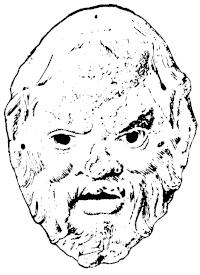
Though the Greek and the Roman house differed considerably in detail, in a general way the two were similar. For Americans the simplest comparison to make would be with the Spanish type of dwelling in California and other parts of the Southwest, since all three have the common characteristic of looking in, rather than out. The exterior presented a blank wall, usually of brick, broken by a door and a few windows. An open courtyard formed the center of the Greek house, and this manner of building was borrowed by the Romans as their wealth increased and larger and pleasanter houses were desired. The Roman house, which grew by the addition of rooms to the original single-room hut, had a large opening in the roof of the principal room or atrium, to provide light and allow the smoke from the hearth to escape. Under the opening was a basin, called impluvium, into which fell the rain-water from the roof. These features were retained even after the atrium was used only as a reception room, the household work and cooking being done in a separate kitchen.

FIG. 21. ROMAN WALL-PAINTING

FIG. 22. CUBICULUM
Houses were usually built of sun-dried brick on a stone foundation. The roofs were often flat and were sometimes covered with hardened mud, but tile roofs were also common. Marble for columns and other decorative features was introduced into Rome in the later part of the Republican period and colored marbles were used freely by the rich Romans of the Empire. Walls were covered with stucco, which was frequently painted. There was no wall-paper, of course, and pictures were painted directly on the walls. Fashions in decoration changed as they do at present, though more slowly. The wall-paintings from a villa near Boscoreale, in the Eighth Room, illustrate several types in use in Italy in the first century A.D. The earliest style imitated columns, marble panels, or other ornamental features employed in buildings. Arabesques and fanciful combinations of foliage, birds, animals, and[22] masks came into use later. Mythological and genre scenes, as the lady with the kithara (fig. 21) and the group of a man and a woman seated side by side, required a skilful painter and were naturally reserved for the principal rooms. In the cubiculum (fig. 22) another style has been employed, in which buildings, arches, porticoes, and gardens are combined in a way which, while of course somewhat fanciful, still probably represents the general appearance of the streets and houses of Pompeii and other cities of the time. Stucco reliefs, of which there are several graceful examples in the Museum, were used in Greek houses of the Hellenistic period as well as in Italy.

FIG. 23. MOSAIC PICTURE
Floors in early times were of hardened earth, paving stones, or plaster. In the fifth century pebbles set in cement came into use in Greece, and from this kind of floor mosaic, plain and patterned, was derived. Pictures or decorative designs made of fine glass mosaic were also used as wall decorations. Three examples are on the tops of Cases 1 and 2 (fig. 23).

FIG. 24. OLD MAN SEATED ON A KLISMOS
The Greek and Roman furniture which has come down to us is necessarily small in amount and fragmentary because,[23] like most modern furniture, it was made of wood and consequently has been destroyed by damp. There remain, however, some fairly complete pieces, and a considerable number of metal fittings and casings, as well as some models and many illustrations from vases. Among the objects from Cyprus in wall-cases in the corridor are two bronze tripods, and three ornaments consisting of goats’ feet and bulls’ heads from another. The bronze lions’ paws were feet for a large chair or chest. We have also a little terracotta chair with a diminutive figure in it and a three-legged table of the kind used to set beside a dining-couch, both from Cyprus, as well as a round table on three legs, of much later date (Case 2). Two lekythoi in Case K in the Fourth Room, decorated with interior scenes, show chairs of a very graceful and comfortable type, the Greek klismos, and the same kind of chair is seen on the[24] grave-monument of a lady in the Sculpture Gallery (No. 4), and on a large amphora on a pedestal in the Fifth Room (fig. 24). The lady playing a kithara in the wall-painting in the Eighth Room is seated in a large armchair, the thronos. In Case 5 is a bronze casing of beautiful work for a piece of furniture, and in Case 2 a bronze chair-leg and an ornament terminating in the head of a young bullock. Two tripods and some bronze mountings from Cyprus will be found in wall-cases in the corridor. In the cubiculum from Boscoreale is a table of marble and bronze. The bronze rim which surrounds the marble top is inlaid with silver and niello in a beautiful pattern of palmettes and rosette ornaments. A couch, probably for dining (wrongly restored as a seat), and a footstool stand in the corridor between the Eighth and Ninth Rooms. Bedsteads, which were similar to this couch in shape, were merely frames on which thongs were stretched, like the old-fashioned corded beds, the interlaced leather bands acting as springs. The wooden frames were frequently decorated with bronze fittings, and in the Hellenistic and Roman periods inlay and mountings of silver, gold, ivory, and tortoise-shell were employed for the rich. Couches and beds were usually supplied with a raised head-rest, often finished with bronze animal-heads, such as the mule-heads in Case A in the Seventh Room and Case L in the Eighth Room.

FIG. 25. BRONZE CAULDRON

FIG. 26. GREEK TABLE-WARE OF PAINTED TERRACOTTA
Clothing was kept in chests, which were well adapted to the large pieces of cloth composing a costume. A good illustration of a chest may be seen in Case W in the Fourth Room, on an amphora decorated with a scene from the story of Danaë and Perseus, and in Case 2 there is a miniature chest of white stone from which the cover has been lost.

FIG. 27. BRONZE PATERA
Household utensils, since they were made of metal or pottery, exist in considerable numbers. Cooking was usually done over an open fire, though stoves of a simple type came into use in the Hellenistic and Roman periods. The bronze cauldrons used for boiling (Case S in the Third Room and wall-cases in-the corridor) were valued highly, and were offered frequently as prizes in athletic contests (fig. 25). At the funeral games of Patroklos (Iliad XXIII, vv. 267-268) Achilles gives a ‘bronze cauldron untouched by fire’ as a prize for the chariot race, and records of later contests prove that the custom was a common one. An amphora in Case Y in the Fourth Room is decorated with the figure of a youth, evidently a victor in the games, carrying away upon his shoulders a cauldron which he has won. The metal hook in Case N in the Seventh Room was used for drawing pieces of meat from the cauldron. Pails, finely made and decorated, especially as to the handles and their attachments, probably served some purpose at table, as, for example, to hold cold water or snow in which a vessel of wine was placed to cool.

FIG. 28. BRONZE WINE-JUG

FIG. 29. BRONZE JUG

FIG. 30. BRONZE BEAKER

FIG. 31. BRONZE LADLE FOR WINE
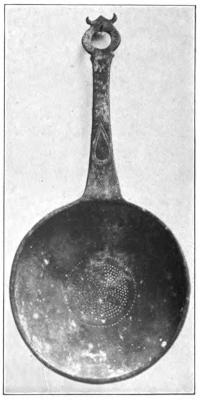
FIG. 32. BRONZE WINE-STRAINER
The pottery in the various rooms of the collection shows the kinds of dishes in use in Greek and Italian houses. There are cups of different shapes, pitchers and jugs for water, wine, and other liquids, kraters (large bowls for mixing water and wine), plates for food, and lekythoi (oil-cruets) (fig. 26). The modern china, that is, high-fired pottery covered with a vitreous glaze, was not known, and glass did not become common until the Imperial period. In the Eighth Room and the corridor are many examples of the glass vessels of that time, some plain, others with ornaments in relief, and still others of colored glass in patterns of remarkable beauty (Cases N and O in the Eighth Room). Much of the plain glass has become iridescent owing to exposure to damp in graves. The pottery in museum collections is naturally the finer product of the workshop; receptacles for storing and for kitchen use were of undecorated[29] clay and more carelessly made. In the Cesnola Collection on the tops of Cases 58-63 are some of the tall jars, called pithoi by the Greeks and dolia by the Romans, which were used for storing and exporting wine, grain, and many other articles, taking the place of the casks, barrels, and boxes, and the paper bags and cartons of modern times. The pointed ends were driven into earthen floors.
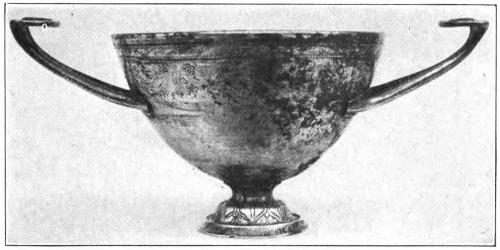
FIG. 33. ROMAN SILVER CUP
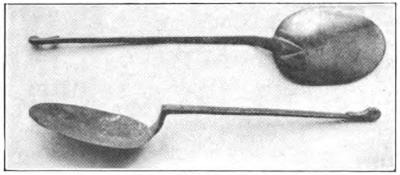
FIG. 34. ROMAN SILVER SPOONS
Another piece of table-ware which should be mentioned is a special plate for fish, made in Italy, which had a depression in the center for holding the sauce. These plates are decorated with interesting and surprisingly accurate drawings of fish (Case Q in the Sixth Room, tail-piece, p. 31).
In Case E in the Third Room is a bronze table service of Greek work from an Etruscan tomb, and in Case O in the same room are bronze jars and jugs of various fine[30] shapes (figs. 27-30), and ladles for dipping wine (fig. 31). In Case A in the Fourth Room is a wine-strainer (fig. 32). The remarkably beautiful handles from vessels in these cases are a further proof of the taste and care expended upon household utensils. Silver table services were not common among the Greeks, but silver and even gold dishes were used by wealthy Romans. In Case C in the Eighth Room are four cups of Roman date (fig. 33) with a ladle and a little jug or cup with a spout.
Food was usually cut into convenient pieces in the kitchen and eaten with the fingers, but spoons were used to a considerable extent by the Romans. Several bronze spoons are exhibited in Case 5, and there are some silver spoons of various shapes in the case with the silver cups in the Eighth Room (fig. 34).
The habit of rising and going to bed early which prevailed in Greece and Italy is easily understood when we see the meagre arrangements for lighting which they possessed. In the street torches were carried, and they were also used in the house in early times. A bronze torch-holder of the late sixth century from Cyprus in the corridor and a terracotta example in Case 2 appear to have been made so that they could be set on a table. The Romans and Etruscans made candles of pitch and also wax ones very similar to our own, but the Greeks were not acquainted with them[31] until they were introduced by the Romans. The iron candelabrum in Case S in the Third Room was designed to hold candles on the prickets around the top. Lamps were commonly of terracotta or bronze. Olive oil was burnt in them with a wick of flax, but at best the light must have been poor and flickering. Candelabra were commonly made of wood, but handsomer ones were of bronze. A fine Etruscan candelabrum stands in the Fifth Room. It was probably furnished with hooks or other attachments for hanging lamps, or with prickets for candles (fig. 35). A group of lamps of various shapes is shown in Case 2 (fig. 36).

FIG. 35. BRONZE CANDELABRUM

FIG. 36. BRONZE LAMP ON A STAND
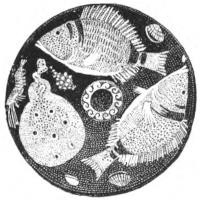
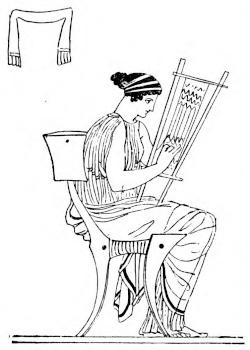
FIG. 37. WOMAN EMBROIDERING OR MAKING A NET
The home in ancient times, especially the country house, was a manufactory on a small scale, like many American homes of a century ago. Most of the clothing for the family was made there, and consequently the mistress of the house must understand wool-working in every stage and the making of linen cloth, and must also be able to teach and direct the slave women. Wool was often bought in the raw state or even in the fleece, which necessitated cleansing it, certainly a disagreeable task. The Syracusan lady in the Fifteenth Idyll of Theokritos scolds because her husband has bought five dirty fleeces of poor quality—“work upon work” for her. For making the roves a pottery shield, called epinetron or onos, was placed[33] on the knee and the fibers rubbed over it. An interesting example, decorated with drawings of women at work (see head-band, p. 32), has the upper surface covered with a scale pattern which furnished the slightly roughened surface necessary for making the roves (Case 2, top shelf, fig. 38). The covering, however, was sometimes dispensed with; a finely decorated toilet-box in Case A in the Fourth Room has on one side a drawing of a woman carding over her bare knee (fig. 39). This box also shows the next stage in the making of cloth, the spinning, for which distaff and[34] spindle were used (see tail-piece, p. 39). A small weight, the spindle-whorl, usually of terracotta, was attached to the thread below the spindle to increase the twisting motion. An example is in Case 5. This primitive method of spinning is still in use among the Greek country-folk, witness a photograph taken in 1922 (fig. 41).
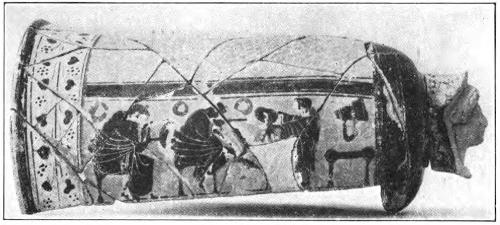
FIG. 38. ONOS OR EPINETRON
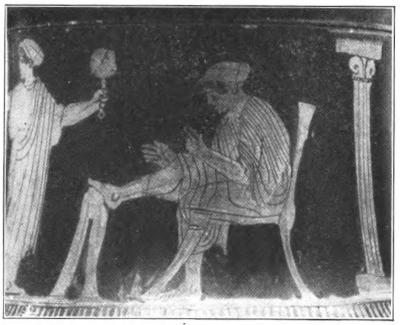
FIG. 39. WOMAN CARDING WOOL
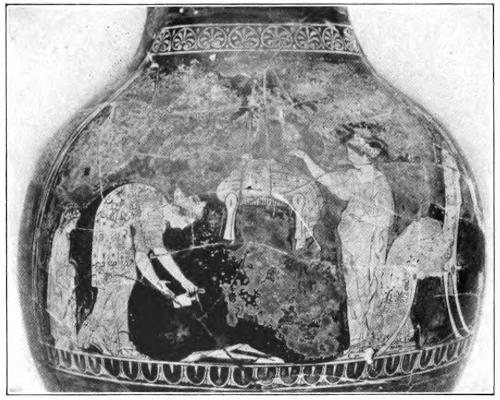
FIG. 40. EMBROIDERED CLOTHING
The loom used in Greece and Italy was upright, consisting of two posts with a cross-bar. The threads of the warp, alternately long and short, were held by terracotta weights tied to the lower ends. A loom-weight from Crete is marked with the owner’s name, Kaleneika, wife or daughter of Teriphos (Case 5).
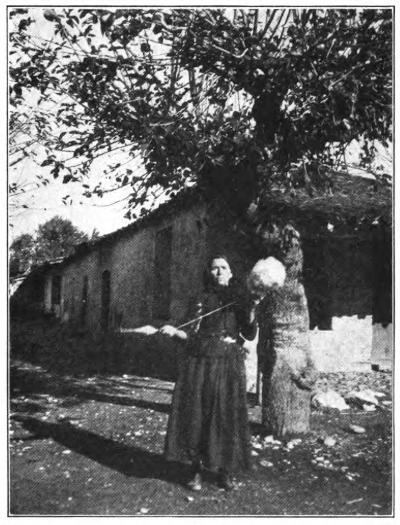
FIG. 41. GREEK COUNTRY-WOMAN SPINNING
Cloth was woven in the size desired for a particular garment, so that no cutting was necessary and consequently there were no edges to hem. Sewing was therefore restricted to seams, of which few were required, but a great deal of time and skill could be devoted to embroidered ornament upon fine garments. The earlier fashion, seen[35] on black-figured vases, was to cover the cloth with patterns, but later only borders were used, or bands of figures. On an oinochoë of the fifth century, in Case C in the Fifth Room, are two ladies perfuming clothes. The garments and head-dresses they are wearing and the clothes they are folding are worked with beautiful borders in the wave pattern and ornaments in the form of conventionalized flowers (fig. 40). Besides providing fine apparel for themselves and their families, women also expended their skill on garments which they offered to the goddesses: the treasuries of Athena and of Artemis at Athens contained chests full of many-colored robes offered by worshippers (fig. 37). Naturally in the course of time various industries sprang[36] up which contributed manufactured products to the household, but spinning and weaving continued to be domestic occupations, at least to provide clothing for the slaves. Some conservative families in Rome prided themselves upon wearing garments made at home; the Emperor Augustus is said to have worn, except on special occasions, the handiwork of the ladies of his family as an example of simplicity in a period of general extravagance.

FIG. 42. BAKING BREAD IN A PRIMITIVE OVEN

FIG. 43. WOMEN WINNOWING AND GRINDING CORN
The preparation of food likewise required the housewife’s direction, though the master of the house, or in large establishments a trusted steward, attended to the marketing. Two small terracottas from Cyprus on the bottom of Case 3 illustrate the making of bread by very primitive methods. In the first (fig. 43), the woman at the[37] left is winnowing grain with a sieve, which she holds, and a winnowing-fan shaped like a shovel, which lies by her side. The other woman (whose head is unfortunately missing) is grinding the corn on a saddle-quern; she draws the upper millstone back and forth over the lower, which is provided with side boards to prevent the meal from falling off—a hard day’s work, one would say. The other terracotta represents a primitive method of baking bread. A clay oven like a huge bowl was built up by hand in a convenient place. The usual fuel, dried grasses, was placed in and around it and after the oven became heated and the fire had died down, the housewife set the flat loaves around the inside to bake (fig. 42).
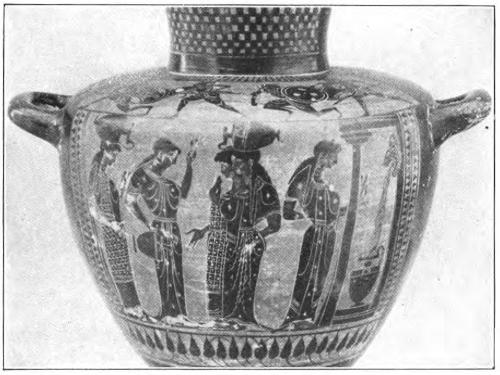
FIG. 44. WOMEN AT A WELL-HOUSE IN ATHENS
Another task often represented on vases is the drawing and carrying of water. In many places the public well-houses were the principal source of supply, as the piping of water into dwellings was unusual in Greece until Roman times. A hydria in Case 2 shows a group of women carrying[38] away their jars on their heads from a public well-house (fig. 44).
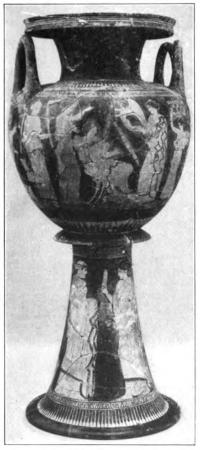
FIG. 45. MARRIAGE-VASE
In Athens, and probably more or less throughout the Greek world, a woman’s life was rather monotonous. Ladies did not go out unattended, and indeed were not expected to go out at all without good reason. A wife did not receive her husband’s guests or take part in his social life; but women were included in family gatherings such as weddings and dinners after the birth of children, they made visits to women relatives and friends, and shared in the frequent religious festivals, which at Athens included the theatre. In the earlier vase paintings there are comparatively few figures of women, and such as appear are usually goddesses or accessory persons in mythical scenes; but with the gradual change to subjects taken from every-day life in the later sixth and the early fifth century, we begin to see women about their usual occupations, or in groups talking with each other or with men. Much of the later Athenian pottery is decorated with charming scenes from the life of women, showing them with their children, at their toilet, busy with embroidery, or playing with pets. The younger ones seem to have enjoyed[39] some games which we have relegated to childhood, such as spinning tops (see fig. 53). On the marriage-vases we see the bride being dressed by her friends and servants, or receiving presents on the day after the wedding, the traditional occasion for the presentation of gifts. Two of these vases are in Case B in the Fifth Room (fig. 45), and a perfume vase in Case Q is decorated with a similar scene. The usual presents seem to have been bands and ribbons for the hair, perfumes, jewelry, and pets, especially birds.
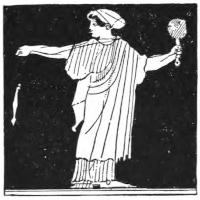
Little babies were tightly bound in swaddling clothes soon after birth, and the mother, in anxiety for her child’s safety, usually fastened an amulet or charm of some kind around its neck to keep away unfriendly spirits. The grotesque faces of colored glass previously mentioned (p. 8) may have served this purpose. Roman children wore the bulla, a case of leather or gold, according to the means of the parents, containing a charm. A large gold bulla of Etruscan workmanship is in a case at the left side of the Gold Room (fig. 46). The baby became the charge of an old and trusted slave-woman such as the kind old nurse represented in a terracotta statuette on the middle shelf of Case 3. Another of the same type is in Case K in the Sixth Room (fig. 47). The prettily decorated jug with a spout is a feeding-bottle (fig. 48).
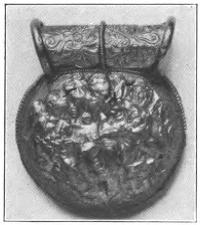
FIG. 46. GOLD BULLA

FIG. 47. OLD NURSE HOLDING A BABY
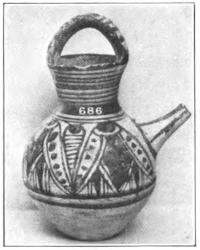
FIG. 48. TERRACOTTA FEEDING-BOTTLE
Greek and Roman children played with toys much like those of the present day, but they were simple and inexpensive. Rattles for babies were made of terracotta with a few pebbles enclosed (Case 3, middle shelf). An interesting toy for a small child is the terracotta horse from Cyprus with large jars in its panniers such as those carried by real horses for taking provisions to and from market (Case 2, top shelf, fig. 49). Carts were favorite playthings; a small oinochoë in Case 3 shows a boy driving two goats harnessed to a chariot, and on a white lekythos painted for a child’s grave (Case F in the Fifth Room), a little boy is going to Charon’s boat for his journey over the Styx, drawing his toy cart (fig. 50). Of course, Greek and Roman children kept house with their dolls, and charming miniature vases were made for them, some for the doll’s table and others for her toilet and wedding. These vases, which are decorated with scenes of children at play, were given, it is thought, as presents on a festival day called Choes, “Jugs.” A number of different types are in Case G in the Fifth Room.
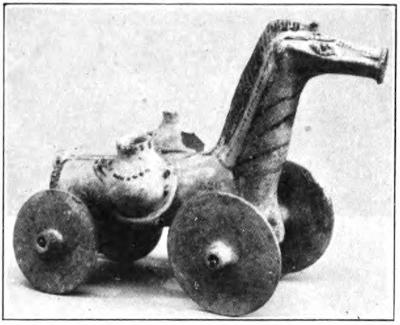
FIG. 49. TOY HORSE ON WHEELS
Dolls were made of wax and clay. The two seated terracotta dolls without joints in Case L in the Seventh Room were found in graves at Tarentum in Southern Italy. Another made of bone has jointed arms and could easily be dressed (Case 3, tail-piece, p. 46). These dolls were originally painted in bright colors, which have been destroyed by time.

FIG. 50. TOMB LEKYTHOS. CHILD DRAWING A CART
Rolling hoops, contrary to modern ideas, seems to have been a boys’ sport. A boy with a hoop may be seen on a vase in Case J in the Fifth Room (fig. 52). Mothers and nurses swung small children in swings, as in the scene on a vase from Southern Italy (Case P, Sixth Room), and older girls also enjoyed this pastime. As part of a game or perhaps as forfeit, girls sometimes carried one another on their backs. A terracotta statuette represents two girls playing ephedrismos, as this game was called (Case 3, fig. 55). Young women and girls, as well as boys, played with whipping-tops, as is shown on a lekythos on the same shelf (fig. 53), and on one side of a toilet-box two girls are[43] playing a game of ball with a wicket (fig. 51). Children also played hide-and-seek, tug-of-war, and many games with beans, nuts, pebbles, small coins, and the astragals described in the section on Amusements (pp. 68-69).

FIG. 51. GIRLS PLAYING BALL
At about six years of age Greek boys were sent to school, while the girls remained at home to learn from their mothers how to spin and weave, and to read a little and keep accounts. Their education was of the simplest kind and ceased very early.
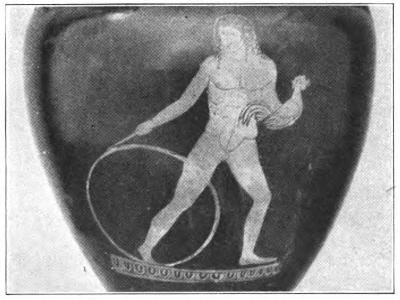
FIG. 52. BOY ROLLING A HOOP

FIG. 53. WOMEN WHIPPING TOPS

FIG. 54. STYLUS
The first school to which a boy went was that of the letter-teacher, who taught reading, writing, and simple[44] arithmetic. A kylix in Case 3 (see head-band, p. 40) is decorated with figures of schoolboys, one of whom holds a roll of manuscript, and another a writing tablet. These tablets were thin pieces of wood covered with wax and fastened together with cords (fig. 56). A pointed stylus (fig. 54) was used for writing, the blunt end being turned around when it was necessary to erase by smoothing the wax[1]. After three or four years in the letter-school[45] the boys went to the music teacher, who taught them to sing and to play the lyre, and in connection with the music they learned many selections from the great poets. Training in the palaistra or wrestling-school was begun very early, and was usually continued until the boy was old enough to be called into the military service of the state. These lessons will be described in the section on athletics, as the sports of the palaistra were in general the same as those of the men’s gymnasium. In addition to the subjects already mentioned, many boys, during the fifth century and later, studied geometry, rhetoric, and philosophy.
[1] Several very interesting objects illustrating Greek writing and writing-materials are exhibited in the case devoted to learning in the Seventh Egyptian Room. They include a wooden tablet covered with wax, several short letters on potsherds—a cheap and common writing-material—and fragments of the Iliad and the Odyssey on papyrus, the usual substance on which books were written, dating from the third century B.C. The reed pens in this case are of the kind employed for writing on papyrus.
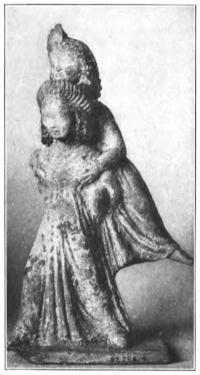
FIG. 55. EPHEDRISMOS GAME
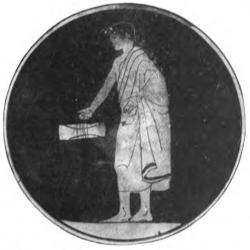
FIG. 56. BOY WITH A WRITING TABLET
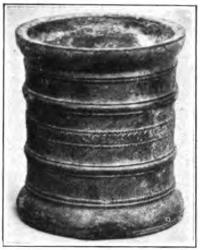
FIG. 57. INK-POT
In Italy, Greek ideas of education were generally adopted; boys learned the Greek language and studied the Greek and Roman poets. A little geography and history were taught, and arithmetic occupied much time, for the Roman system of weights, measures, and coins was difficult and inconvenient. Besides the schools for elementary subjects there were special[46] classes for the study of rhetoric and philosophy. The children of rich or noble families were often educated at home by Greek tutors, the girls and boys together, and among the humbler people they went to the same school for a time. In general the education of girls was similar to that of boys, so far as it went, and sometimes in wealthy families was continued after marriage. Many ladies knew the Greek poets well and wrote verses themselves. Music occupied much of their time and they learned to dance for recreation and as a means of giving pleasure to their families and friends.


FIG. 58. DIAGRAM OF DORIC CHITON
Greek dress, both for men and women, consisted of two portions, a garment for the house and a wrap to be worn over it. Men, from the time of the Homeric poems downwards, wore a “chiton,” rectangular in shape and somewhat wider than the body, closed on the sides and across the top except for openings left for the head and arms. A short woolen chiton was the usual dress for soldiers, workmen, and poor persons, while the nobles of the Homeric poems seem to have worn linen chitons reaching to the feet. Over this a wrap, either rectangular or curved on one side, was arranged in various ways. The earliest representations show men wearing a wrap with one curved edge, and apparently doubled like a shawl. This type of dress may be seen in vase paintings in the Third Room; for example, the figure of Dionysos on a[48] stamnos (No. GR 564 in Case R), and the same god on a large amphora (No. 12.198.4) in that case.
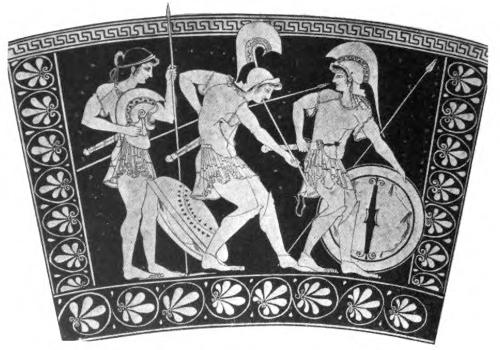
FIG. 59. AMAZONS IN MEN’S IONIC CHITONS
The earliest garment for women which we know of was a chiton of wool without sewing. This was a large rectangular piece of cloth considerably wider and longer than the body. It was folded through the middle lengthwise, so that one side was closed and the other open. The top, again, was generally folded over, this hanging portion being called “apoptygma.” Long pins inserted with the points upwards, or fibulae (see head-band, p. 47), were used to fasten the double edge on the shoulders, and a girdle was usually worn to hold the edges of the open side in place (fig. 58). If the chiton were still too long, part of the cloth was drawn up through the girdle into a blouse called “kolpos.” The heavy woolen chiton may be seen in the drawing of three nymphs on an amphora (No. GR 549) in Case K in the Third Room. From these early representations in art, it seems that clothing for both men and women was at[49] first rather narrow and was often covered with woven or embroidered patterns (fig. 60).
During the seventh and sixth centuries the rich and artistic Ionian cities had a great influence on the customs of Greece, and from them the ladies of Athens adopted the linen chiton, which was wider and was sewed on the sides. The additional width was sometimes used to form sleeves by catching the two pieces together at the top in three or four places, with sewing, buttons, or small pins. Long sleeves sewn in were occasionally worn, but were exceptional rather than customary, so that artists often represent barbarians with sleeves to distinguish them from Greeks. On a kotyle in Case C in the Fifth Room is a woman wearing a spotted chiton with long, close-fitting sleeves. At this period men as well as women at times[50] wore the apoptygma and kolpos, but the man’s chiton was generally short (fig. 59). On two kylikes on the bottom of Case L in the Fourth Room (Nos. 12.231 and GR1120) women are represented in the linen chiton (fig. 62). After the Persian Wars, as the result of the strong reaction against Eastern fashions, men and women both adopted the woolen Doric chiton again, and for men it remained the universal dress, being now short and without apoptygma and kolpos. Still, the adoption of the Doric chiton did not imply a violent change, for working people had worn it continuously and it was the usual dress for young girls. Old men, priests, charioteers, and officials on public occasions continued to wear the long Ionic chiton, and both were in use by ladies at the same period. It should be added that at this time the two types were often worn together, the Ionic forming an undergarment with short sleeves, and the Doric, a sleeveless gown. This costume is frequently seen on grave-reliefs, but our only example is an engraving of a Maenad on a bronze mirror in Case C in the Sixth Room.
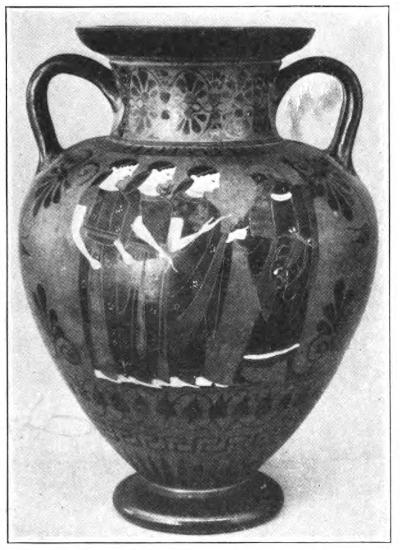
FIG. 60. EARLY CHITONS
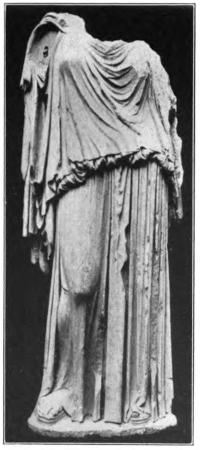
FIG. 61. WOMAN’S DORIC CHITON OF THE V CENTURY
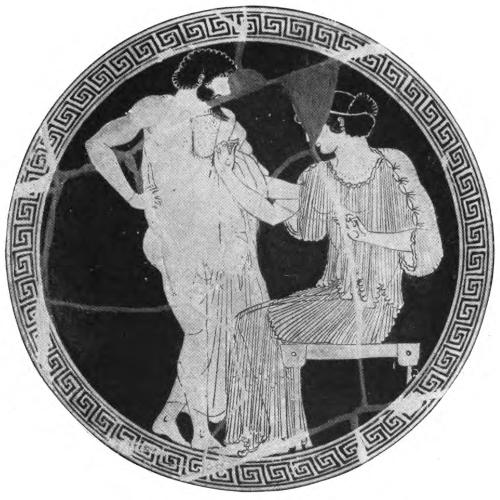
FIG. 62. WOMAN IN IONIC CHITON
The woman’s Doric chiton of this time may be seen in the statue of Eirene, No. 15 in the Sculpture Gallery (fig. 61), and it is worn without a girdle by the young girl on a gravestone (No. 21, fig. 63). Here the open side shows plainly. A drawing of Zeus on a krater on the bottom of Case O in the Fourth Room, and a young hunter on a krater on the left side of the first shelf show the man’s chiton (fig. 67). The Ionic chiton is illustrated by the statue of a goddess, No. 19 in the Sculpture Gallery. Metal buttons to represent the sleeve fastenings were inserted in the marble.
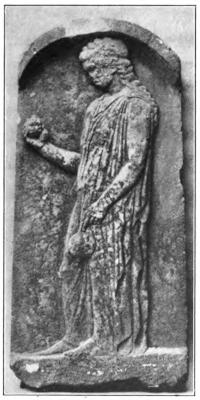
FIG. 63. DORIC CHITON WITHOUT GIRDLE
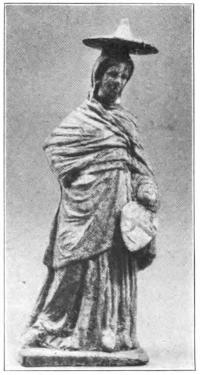
FIG. 64. LADY IN HIMATION AND HAT

FIG. 65. LADY IN HIMATION
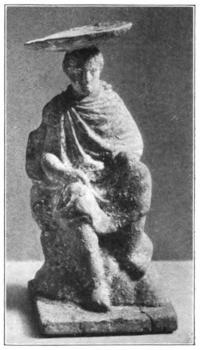
FIG. 66. MAN IN RIDING-CLOAK AND HAT
The usual outer wrap, called himation, was a large oblong, rectangular piece of woolen cloth, and was practically the same for both sexes. In the seventh and sixth centuries there were various ways of arranging it; as a shawl, or as a scarf fastened on one shoulder. The archaic statue of a woman, No. 2 in the Sculpture Gallery, wears it doubled and fastened on one shoulder over an Ionic chiton of soft, crinkled linen (fig. 68). Gradually a simpler and more beautiful arrangement was adopted; the himation was laid across the back with one corner over the left shoulder, then folded around the front of the body, passing either over or under the right arm according to the wearer’s wish, and the end thrown over the left shoulder, from which it hung down the back, kept in place by a weight in the corner. On a krater (No. 16.72) on the bottom of Case J in the Fourth Room, the god Dionysos is[54] wearing the himation arranged in this way (see tail-piece, p. 67), and the cast of the so-called Lateran Sophokles (No. 775 in the Gallery of Casts) shows the himation at its best. Ladies often drew it up over their heads like a veil. The terracotta statuettes in the Sixth Room illustrate the variety of ways in which the wrap could be draped (figs. 64, 65). Besides the himation there were cloaks of more convenient dimensions for riding, hunting, or traveling. These were variously named but were all unsewn pieces of cloth, rectangular or curved on one side, and were usually pinned on one shoulder. A terracotta (No. 06.1118) in Case G in the Sixth Room represents a traveler in chiton and riding-cloak (fig. 66), and the same cloak is worn by a warrior on the large amphora on a pedestal in the Fifth Room (see fig. 103).
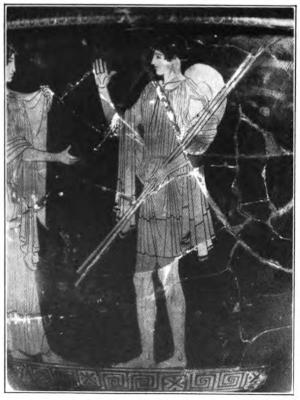
FIG. 67. MAN’S CHITON
Head-coverings were worn only by travelers, riders, or working-men. A hat with a wide brim, called “petasos,” was the usual traveler’s head-gear. It was made in a variety of shapes, the brim being sometimes broader at back and front, sometimes at the sides. Another form had a circular brim which turned up. This may be seen on three terracotta statuettes (Case 2, and Case G in the Sixth Room). A cap, called “pilos,” was worn by smiths, sailors, and working-men in general. There is a man[55] wearing a pilos on a cup on the top shelf of Case S in the Fourth Room, and a warrior with the same hat will be found on a small hydria on the first shelf of Case Q in the Fifth Room. Some head-coverings which may be either caps or small hats with rolled brims, are represented in several terracotta statuettes of boys in Case G in the Sixth Room. Women wore the petasos for traveling, and they also used a kind of sun-hat, called “tholia,” with a pointed crown and broad brim, made of straw and fastened by a ribbon. Several examples of this stiff and ungraceful hat may be seen on terracotta statuettes in Case 2, and in Case G in the Sixth Room (see fig. 64).
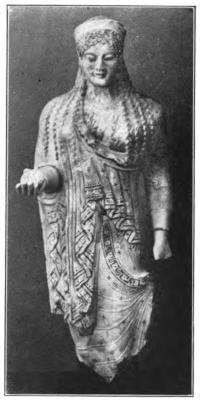
FIG. 68. AKROPOLIS MAIDEN IN IONIC CHITON AND HIMATION
Shoes were of two principal types: sandals with straps, and high shoes or boots for hunting and traveling. The Greeks valued finely made shoes, and dandies sometimes invented new fashions which were called by their names, as “Alkibiades shoes.” A terracotta foot from Cyprus wearing a sandal and another painted black are on the middle shelf of Case 2. On a krater in Case O in the Fourth Room Hermes wears high laced boots with a tongue rising above the laces, and a stamnos on the bottom of Case E shows the hunter Eos in boots. The bronze statuette of the philosopher Hermarchos in the Seventh Room wears sandals which are worked out in detail (fig. 69), and an[56] idea of the thickness of the soles may be gained from those worn by the woman on a stele, No. 4 in the Sculpture Gallery. The number and arrangement of the straps which held the sandal in place were various and they were sometimes broad enough to form what was practically a shoe. Boots were at times made with the leg-covering composed of leather bands resembling modern puttees. Women wore sandals or low shoes. Black was the usual color for foot-coverings, but gay colors were worn by women and young men. The warm climate and custom permitted people often to dispense with shoes in the house, and working-men went barefoot.

FIG. 69. GREEK SANDAL
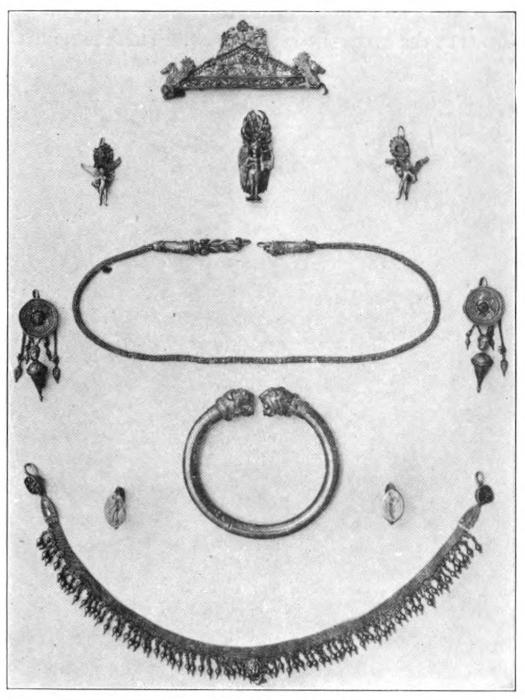
FIG. 70. GREEK JEWELRY
The hair was worn long by men until the fifth century, and the Spartans and Athenian gentlemen who admired Spartan ways continued the fashion. It was sometimes allowed to fall on the shoulders in curls or braids, but was more frequently braided in two plaits and wound around the head, or made into a sort of roll at the back and fastened by a gold pin. In the sixth century men wore pointed beards without moustaches, but later it became customary to shave the entire face, though short beards and moustaches were worn by older men. A warrior arming, on an amphora on the bottom of Case 4, has a pointed beard and long hair. His young squire, who stands behind him, is beardless but his hair is long and curling. The lyre-player on a large amphora on Pedestal R3 in the Third Room has long hair in a knot at the back, held in place by a band. A somewhat similar arrangement is seen in the bronze statuette of Apollo in Case C2 in the same room. The fashion of plaited hair wound around the head is illustrated by a terracotta relief of Phrixos on the ram’s back in Case E in[58] the Fourth Room. In the fifth century short hair was usual for both young and old men; young men did not wear beards but older men frequently wore short beards with moustaches. A moustache without a beard was regarded as the mark of the barbarian. The marble heads of two young men, Nos. 12 and 14 in the Sculpture Gallery, and the athlete’s head on Pedestal H in the Sixth Room show the fashion for young men, and a comparison of the vases and small bronzes in the Third Room with those in the Fourth Room will make clear the gradual change of style from elaboration to simplicity.
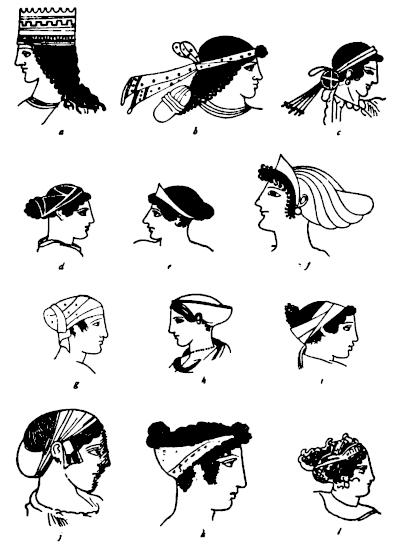
FIG. 71. WOMEN’S COIFFURES
The styles of women’s hair-dressing can be best understood by looking at the statues, vases, and terracottas in the collection. A variety of ornamental kerchiefs was[59] worn, especially a very pretty band called sphendone, “sling,” from its shape (fig. 71). On the bottom of Case J in the Fifth Room is a large stamnos decorated with groups of women dressed in the Ionic and Doric chitons and wearing various kinds of head-dresses. Many of the terracottas in the Sixth Room and the head of a young goddess, No. 7 in the Sculpture Gallery, illustrate the “melon” coiffure which became the mode in the fourth century.
Fashions in dress were the same in general throughout the Greek world, although of course there were local peculiarities. In Sparta boys and men often wore only a small wrap without a chiton, and young men commonly went barefoot. The women wore the Doric chiton.
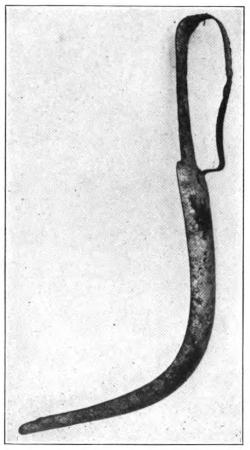
FIG. 72. STRIGIL
The jewelry in use included necklaces and bracelets, rings for the ears and fingers, and pins for the hair and clothes. The Doric chiton originally required two very large pins, which were inserted with the points upwards, but they went out of use in the sixth century when the Ionic chiton came into fashion and were not worn with the later Doric chiton. The fibula or safety-pin was used throughout the Greek and Roman world. A group of these pins of various types is exhibited in Case D in the Second Room. The fibula illustrated in the head-band is in the Gold Room. Greek jewelry of the fifth and fourth centuries was frequently of great beauty. Precious stones were used[60] but seldom until the Hellenistic period, but the excellence of Greek workmanship has rarely been equalled by other craftsmen. The Greek gentleman permitted himself only a handsome ring which was useful as a seal, and the artistic value of these engraved seal rings of gold or of gold set with a semi-precious stone has made them favorites with collectors for many centuries. The rings and gems in cases in the rooms of the Classical Wing, and the beautiful jewelry in the Gold Room are proofs of the skill of Greek workmen and the fine taste of their patrons (fig. 70).
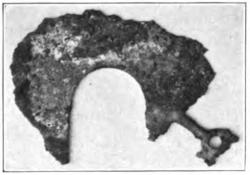
FIG. 73. RAZOR

FIG. 74. ALABASTRON
Roman dress was similar to that of Greece in its principal characteristics. The clothing of women was the same as that of the Greek lady of the Hellenistic age represented in the terracotta statuettes. The Ionic chiton, made usually of wool instead of linen, and called stola, was worn in the house, but the married woman’s stola had a wide piece like a flounce sewn on at the bottom. For the street the himation, called by the Romans palla, was worn over it. The Roman citizen wore a white woolen tunic like the Greek chiton, but it was usually provided with short sleeves. Senators, knights, and free-born children had this tunic ornamented with purple stripes running from each shoulder to[61] the bottom, both front and back. In the statue of a camillus in the Eighth Room the stripes were inlaid in silver, of which traces remain. Over this was worn the toga, corresponding to the Greek himation and arranged in the same general way. The toga, however, was usually larger than the himation and was semicircular on the lower edge. For senators, knights, and children it was ornamented with a broad purple stripe following the straight edge. Shoes and sandals of various kinds were in use; a special kind of high shoe called calceus was always worn with the toga, and the tunic, toga, and calceus formed the regulation dress for citizens in public. The toga, being a very heavy, cumbersome garment, was not worn for traveling or active work, and for these purposes there were many small wraps and longer cloaks of various shapes.
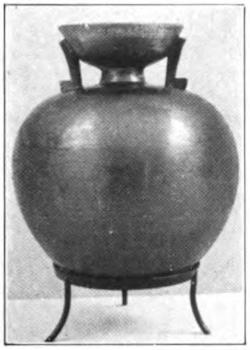
FIG. 75. ARYBALLOS

FIG. 76. GLASS BOTTLE
Short hair was universally worn by men in Rome. Under the Republic women’s hair was simply arranged, but throughout the Imperial period a variety of styles prevailed at different times, most of which were conspicuous for their bad taste and so elaborate that the desired[62] effect was produced by wearing wigs and wire supports. Some of the better styles may be seen on the portraits in the Sculpture Gallery, and on the heads of a girl and a woman on pedestals in the Eighth Room. During most of their history the Romans did not wear beards or moustaches, but under the Empire fashion fluctuated, following the style favored by the reigning emperor. After the time of Trajan beards were usual.
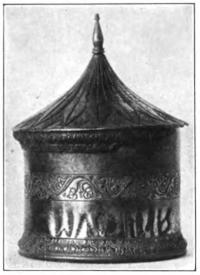
FIG. 77. SILVER PYXIS
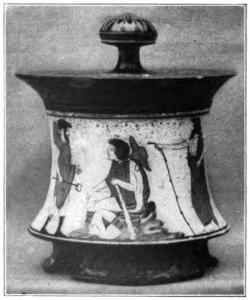
FIG. 78. TERRACOTTA PYXIS
Roman ladies were fond of ornaments and wore a great many of them. Large sums of money were expended on precious stones and on shoes and other garments embroidered with pearls. During the Republican period the Roman wore a gold ring as the badge of his citizenship, but in the Imperial period, with the increase of luxurious bad taste, dandies sometimes covered all the joints of their fingers with rings.
Requisites for the toilet do not differ greatly from one period to another, since the purposes for which they were intended remain practically the same; so we find much that seems familiar among[63] those of the Greeks and Romans. Probably the oldest article in this group is a razor with a crescent-shaped blade, made in Italy in the early Iron Age. The shape seems to have been a common one (fig. 73). Tweezers, of which an example is shown in Case 5, were used for removing superfluous hair. An article of daily use in ancient times, though we have no modern utensil to correspond with it, is the strigil or flesh-scraper (Case 5, fig. 72). It was used especially by athletes after exercise, to remove the dust and sand of the wrestling-ground, so that the strigil, oil-flask, and sponge became in Greece a kind of symbol for the athlete’s life, which was, practically speaking, the life of all well-to-do young men. On a gravestone, No. 7 in the Sculpture Gallery, the dead youth is represented with a strigil in his hand, while his little slave holds his towel and oil-flask. Both men and women used strigils in the bath for scraping off the fuller’s earth or lye powder used as soap. A silver strigil was included in the tomb furniture of an Etruscan lady which is exhibited in Case F in the Sixth Room. There is an example in glass of Roman date in Case 5.

FIG. 79. SPATULA

FIG. 80. DIPPING-ROD
It was customary among the Greeks and Romans to rub the body with oil after the bath. The small jar called[64] aryballos (Case G in the Fifth Room, fig. 75) and the taller alabastron (Case 2, and Case A in the Fourth Room, fig. 74) were used for holding oil and perfumes for toilet use. Some small glass toilet bottles in Case J in the Third Room are so charming in shape and coloring as to make a modern woman envious (fig. 76). In the Gold Room are two crystal scent bottles from Cyprus, one of which has a gold stopper. The toilet box or pyxis held ointment, rouge, face or tooth powders, or small toilet articles or ornaments. These charming boxes were made of metal, as the silver box in Case F in the Sixth Room (fig. 77), or of painted terracotta. The latter are often triumphs of the potter’s and vase painter’s art; for example, the white pyxis in Case V in the Fourth Room (fig. 78) and the red-figured pyxis in Case A in the same room, with its interesting drawings of women working wool (compare fig. 39). Others of a variety of shapes and decoration will be found in Cases C and G in the Fifth Room.
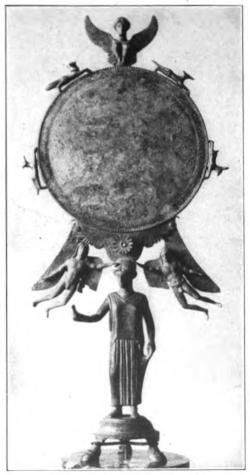
FIG. 81. GREEK MIRROR ON A STAND
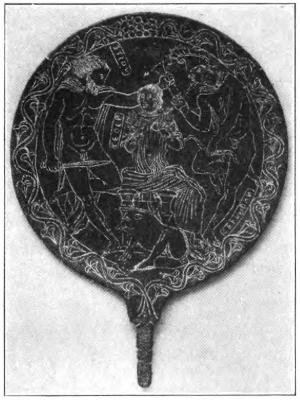
FIG. 82. ETRUSCAN MIRROR

FIG. 83. GREEK MIRROR AND COVER
The bronze boxes known as cistae are Etruscan. Some of those which have been found in tombs are very large and are elegantly decorated with engraved scenes. They seem to have been a kind of dressing-case, for holding all of a lady’s toilet equipment. A small one was included in the tomb furniture of an Etruscan woman which is shown in Case F in the Sixth Room.
Bronze spatulae were useful in a variety of ways for mixing and applying the cosmetics which were employed so constantly by Greek and Roman ladies (fig. 79). An instrument corresponding to our medicine droppers are the dipping-rods of bronze or glass. They could be inserted into bottles or jars to take out a small quantity of liquid. A disk about half way up the rod kept it from slipping into the bottle (fig. 80). Examples of both utensils will be found in Case 5.
Ancient mirrors were as inferior to the modern in power to reflect as they are superior in beauty. Disks of highly polished metal, usually bronze, were employed for this purpose, for the process of making a mirror by backing a sheet of glass is not older than the fourteenth century. Sometimes the mirror consists of a simple disk, plain or ornamented on one side with an engraving or a design in relief, or again it is made in one piece with a long handle or with a short tang to be inserted into a bone or ivory handle, or it is provided with a ring. The disk is often protected with a cover which bears the principal decoration. Etruscan mirrors most frequently have handles but no covers, and are decorated with engraved scenes, usually taken from Greek mythology (fig. 82). Greek mirrors are of two types: either a simple disk without a handle, fitting into a cover, usually ornamented with a relief (fig. 83), or a disk supported on a stand, often in the form of a human figure (fig. 81). In Case A in the Fourth Room are two fine examples of the latter, two stands from which the mirrors have been lost, and a mirror with a cover decorated with a woman’s head in relief. Another charming stand[67] of Etruscan workmanship is in Case H in the Third Room. In Case A in the Fifth Room are four very beautiful Greek mirrors of the fourth century, and in Case C in the Sixth Room are examples of both Greek and Etruscan types. A pretty terracotta statuette of a lady using a mirror is in Case G in the same room; she is arranging her hair while balancing her mirror on her knee.
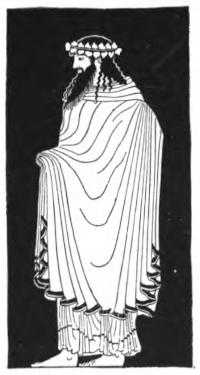
As at the present time, festivities frequently centered around dining. In Greece, many dinners were given by men to their friends, followed by the symposium, at which the guests drank wine mixed with water, told jests, sang, and often watched hired performers, such as jugglers, tumblers, and dancers. A kylix in Case E in the Fourth Room is decorated with a scene from a symposium (fig. 84). The special game for this occasion was “kottabos,” which was played with the aid of a bronze contrivance like a candelabrum, of which an example stands in the Fifth Room (fig. 85). The players held their cups by one handle and tried to throw a small quantity of liquid on the bronze disk at the top of the shaft, so that it fell down with a ringing sound. The game was also played by throwing the liquid into nutshells or small saucers floating in a krater full of water, so as to make them sink. Many games of chance were known to the Greeks and Romans. Perhaps the most popular were those played with the knucklebones (astragaloi) of sheep and goats. They[69] could be used like dice, and also like “jacks,” being thrown up and caught on the back of the hand. A toilet box on the middle shelf of Case 3 (fig. 87) shows three women playing, one of whom has an astragal on the back of her hand. The knob on the cover of the box is appropriately made in the same form. Nine very small examples of glass are in Case 1 (fig. 86). The invention of draughts was ascribed to Palamedes, one of the heroes of the Trojan War, a story which at least proves that they were played in Greece in very early times. Nuts and coins were also used as counters in various games, and games of dice were played in various ways. Astragals could be used as dice, and had the advantage of needing no marks, as the sides were naturally different.
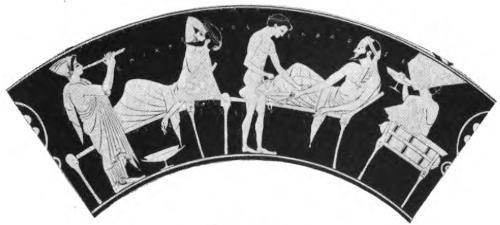
FIG. 84. SYMPOSIUM
The musical instruments in use were the lyre and kithara and the flute, with some other less common varieties of stringed instruments. The kithara, the instrument of professional musicians, had a sounding-board and hollow arms of wood. The strings extended from the “yoke,” a cross-piece connecting the arms, to the sounding-board. The kithara was usually played standing, and was hung by a band to the performer’s shoulders. He played with both hands, using the plectron or “pick” in his right. A[70] rather rude terracotta from Cyprus in Case 1 represents a woman with a kithara, a terracotta statuette of Eros with a kithara is in Case K in the Seventh Room, and a wall-painting in the Eighth Room represents a lady playing one (see fig. 21). Kithara players in festal costume at the public games are represented on three vases in the collection (Case K in the Third Room and Cases E and Y in the Fourth Room). Another illustration is on an amphora on the bottom of Case P in the Fifth Room, where Apollo, the god of music, stands before an altar holding his favorite instrument (fig. 90). The best representation, however, is the kithara held by a gold siren who forms the pendant of an earring exhibited in the Gold Room. The details of construction are fully worked out and the attachment of the strings can be clearly seen. Those used at public festivals were often richly ornamented with carving and inlay of semi-precious stones.

FIG. 85. KOTTABOS-STAND
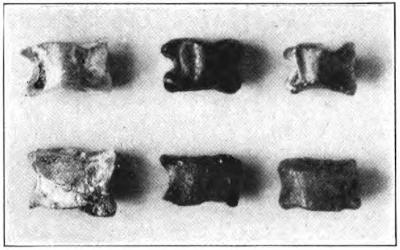
FIG. 86. GLASS ASTRAGALS
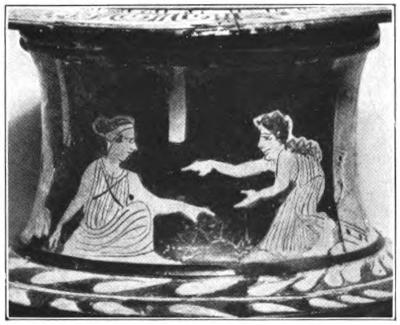
FIG. 87. GIRLS PLAYING WITH ASTRAGALS
The lyre was the usual instrument of the amateur. Boys learned to play it at school, and gentlemen were expected to be able to accompany themselves upon it at symposia. Its sounding-board was made of the shell of a tortoise covered on one side with wood. The upright pieces, curved outward and in again toward the top, were sometimes made of the horns of animals. It had a yoke near the ends of the uprights, and a bridge on the sounding-board. The strings, of[71] sheep’s guts or sinews, varied in number from three to eleven at different periods, but seven was the usual number in the fifth century. The plectron was generally used in playing both instruments. Several good illustrations of the lyre may be seen in the Museum collection. A satyr with a lyre decorates an amphora on the shelf in Case J in the Fourth Room. On the bottom of Case O is an amphora showing Kephalos with a lyre (fig. 88), and on the shelf above a boy singing to the lyre will be seen in the interior of a kylix. A man holding a lyre, probably a guest at a symposium, decorates the inside of a kylix in Case E. An interesting little bronze figure in Case C 2 in[72] the Third Room represents a musician in festival dress with the same instrument. The statuette was probably a votive offering for success in a contest.
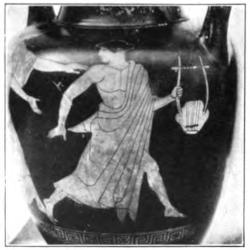
FIG. 88. YOUTH WITH A LYRE
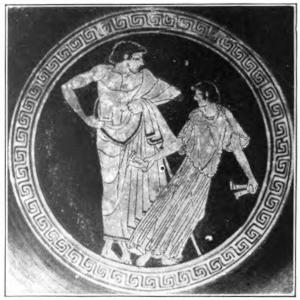
FIG. 89. GIRL DANCING AND PLAYING THE CASTANETS
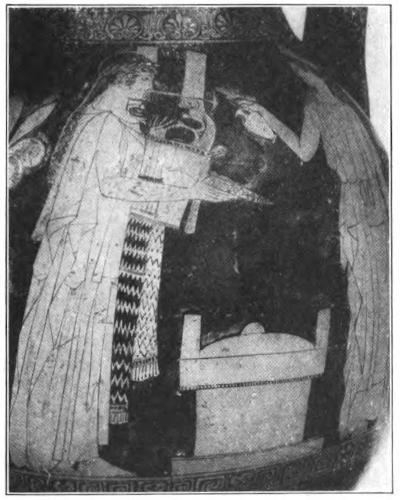
FIG. 90. APOLLO WITH A KITHARA
The ancient flute differed from the modern in being played at the end, and in having a vibrating reed as a mouthpiece. The tone was shrill. Flutes were always played in pairs, and a kind of bandage was often worn by the player to support their weight. This can be seen on the psykter in Case 4 and on a terracotta statuette from Cyprus in Case 1. Flute music had a very wide use. It accompanied the voice in solo or chorus, and the kithara at public contests; it was employed in the theatre at Athens and at Rome, and was used to guide and accompany the exercises of the palaistra. The flute furnished music for dancers, and in Rome it was played at funerals. Meals were served and work such as the kneading of bread in bakeries was done to its music. Flute-cases are often represented in interior scenes in Greek vase[73] paintings, as on the inside of a kylix in Case O in the Fourth Room, showing a boy playing the lyre, and on a lekythos in Case K in that room where a woman is playing the same instrument. Another instrument was the syrinx or Pan’s pipe, made of reeds arranged in graduated lengths, fastened together with cords and wax. It was especially the shepherd’s companion in his long, solitary days with his flocks. The little faun which forms the pendant of the bracelet in Case K 2 in the Seventh Room is playing the syrinx. Cymbals were used principally at religious ceremonies of an orgiastic type. There are two pairs in the collection, one being marked with the owner’s name, Kallisthenia (Case 5 and Case C 2 in the Sixth Room). Dancing formed a part of worship in ancient times. The rude clay groups of men and women dancing[74] in a ring illustrate a feature of the worship of Aphrodite in Cyprus (Case 1). In Greece boys were taught the exercises preliminary to a dancer’s training as a part of their physical education, and the many public festivals gave opportunity for large numbers to progress further. Professional dancers, both boys and girls, were employed to furnish entertainment at symposia. On a kylix on the bottom of Case L in the Fourth Room is a girl dancing and playing the castanets, while a young man looks on (fig. 89). Women of good family danced at home for amusement, and at domestic festivals. The character of Greek dancing was largely mimetic, the movements of the arms and the use of the drapery being very important (see tail-piece, p. 75). The terracotta dancers in Case L in the Seventh Room and another in Case 1 are good illustrations of this (figs. 91-92). The Romans in early times practised religious dancing. The processions of the Salii or priests of Mars, and of the Arval Brothers are the best-known examples of such ritual performances. Dancing as an amusement, however, they adopted from the Greeks in its period of decadence, and consequently the sterner moralists opposed it. Under the early Empire it nevertheless grew very fashionable. Girls and women of noble family learned to dance as an accomplishment, and even men of high rank danced, though at the cost of their dignity. Professional dancers were greatly sought after and admired.

FIG. 91. WOMAN DANCING
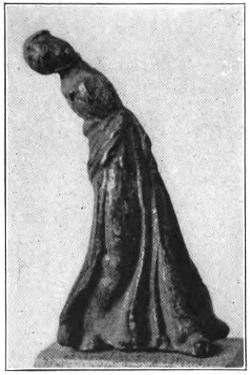
FIG. 92. WOMAN DANCING
Our representations of pet animals are all on articles of Greek manufacture. An old gentleman walking with his sharp-nosed Melitean dog decorates the interior of the kylix by Hegesiboulos in Case K in the Fourth Room. Cocks and quails were kept for fighting by boys and young men. Ganymede on an amphora in Case J in the Fifth Room carries his cock on his arm (see fig. 52). Quails, cranes, small birds, and rabbits were also household favorites. On the perfume vases in Cases Q and C in the Fifth Room, quails, cranes, and a rabbit appear among the groups of women. Cats were probably introduced from the East or from Egypt in the late sixth or the early fifth century, but they were rare and seemed to have been looked upon as curiosities rather than as pets. The goose was perhaps the commonest pet and children are often represented playing with one. Some small boys with two goats harnessed to a little chariot appear on the oinochoë in Case Y in the Fourth Room.
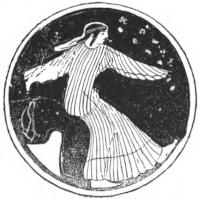
The Greek soldier did not wear a full suit of armor such as that of the medieval knight; the hoplite or fully armed infantryman wore only a helmet, a cuirass, and greaves for protecting the shins. Such an equipment may be seen in the statuette of a warrior of about 500 B.C. of which the original was found at Dodona (top shelf of Case 3, fig. 93). The Romans adopted this armor from the Greeks, with minor changes and variations, but very little Roman armor has come down to our times, since it was almost entirely of iron and has rusted away in the earth where it was buried.
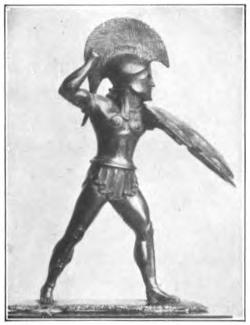
FIG. 93. GREEK FOOT-SOLDIER
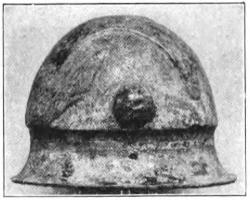
FIG. 94. ITALIC HELMET
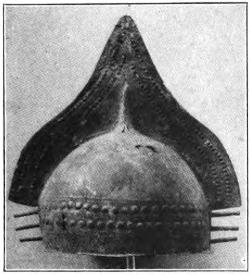
FIG. 95. ITALIC HELMET WITH METAL CREST
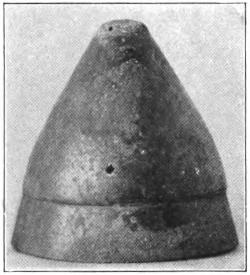
FIG. 96. CAP-SHAPED HELMET
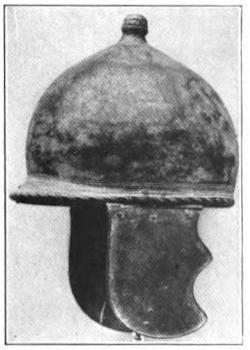
FIG. 97. “JOCKEY-CAP” HELMET
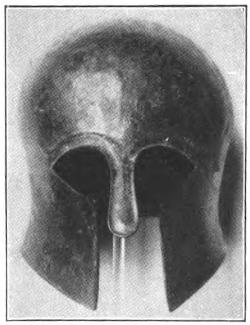
FIG. 98. CORINTHIAN HELMET
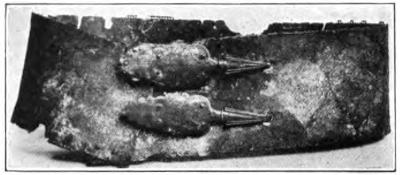
FIG. 99. ITALIC ARMORED BELT
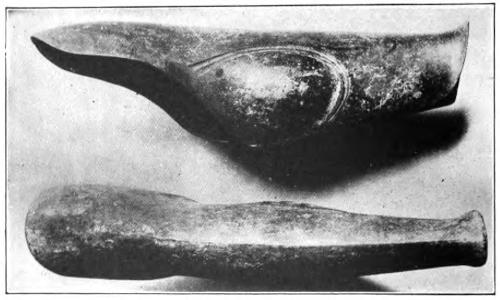
FIG. 100. PAIR OF GREAVES
The earliest Greek helmets were of the type called Corinthian because Athena is represented in this helmet on the coins of Corinth. It formed a complete covering for the head, having openings only for the eyes and mouth. A nose-piece extends downward from the top. Holes for attaching a leather or cloth lining may be seen along the edges of our three oldest examples in Case H 2 in the Second Room. In the later helmets (Case J in the Third Room and Case 4, fig. 98), the shape has improved and the workmanship is finer. These helmets must have been worn over a cap, as there are no holes for sewing in the lining. One example (No. 1530 in Case J in the Third Room) has three small loops for attaching the crest, which was generally made of horsehair. When not in battle the[79] wearer pushed the helmet back until the front rested on his forehead.
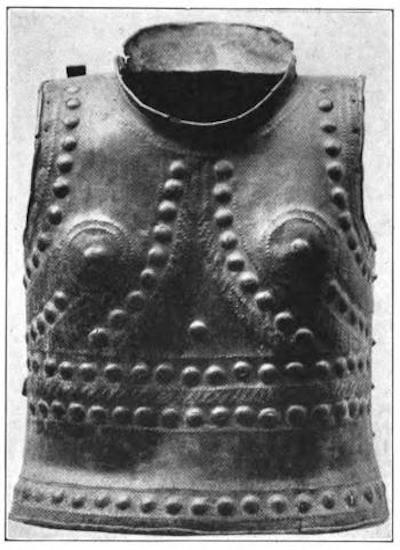
FIG. 101. ITALIC CUIRASS
The Corinthian helmet had the great disadvantage of covering the ears and its shape probably caused it to be easily displaced. An improved form known as the Attic appears during the sixth century. This helmet, of which No. 1535 in Case 4 is an early example, was lighter than the Corinthian, fitted the head better, and had openings for the ears (see tail-piece, p. 88). The cheek-pieces were often provided with hinges and could be turned upwards and away from the face; on the large amphora on a pedestal in the Fifth Room a young warrior is holding a beautiful Attic helmet with cheek-pieces which seem to be hinged (see fig. 103). An example with immovable cheek-pieces in the form of rams’ heads is in Case C 2 in the Sixth Room. Both the Corinthian and the Attic helmet continued in[80] use at the same time, but the Attic type gradually superseded the other. Two helmets (Case 4 and Case C 2 in the Sixth Room) shaped like the pilos or felt cap worn by workmen show a Greek type of the fifth and fourth centuries. One of them (No. 1541) has holes for attaching a crest (fig. 96). The other helmets in the collection are Italic or Etruscan. An Italian helmet reinforced by bands in relief (No. 1558 in Case N in the Seventh Room) is of the same type as those in the British Museum which were found on the battle-field of Cannae (figs. 94, 95, 97).
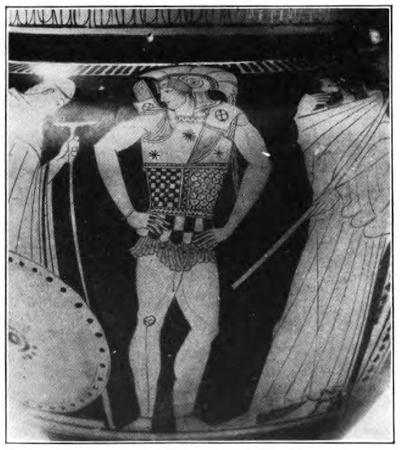
FIG. 102. GREEK CUIRASS OF THE V CENTURY
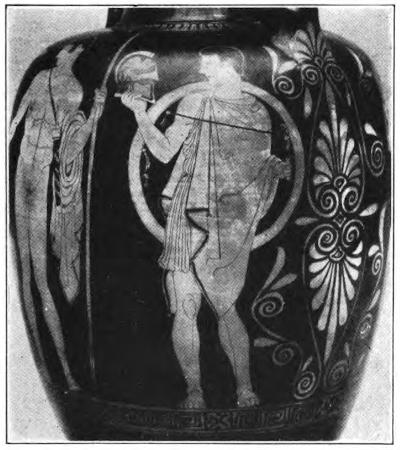
FIG. 103. WARRIOR CARRYING A SHIELD
The earliest Greek cuirass consisted of two curved bronze plates laced together at the sides. It reached to the waist and turned up around the edges so as not to hurt the wearer. The Dodona statuette shows this cuirass, and an Italic example in Case A in the Second Room belongs to the same general type, though it is longer and the lower part is slightly curved out to follow the line of[81] the hips (fig. 101). This heavy and uncomfortable piece of armor was superseded in Greece in the fifth century by a cuirass made of leather or cloth upon which bronze scales were sewn. It was provided with shoulder-straps and a cloth or leather kilt reinforced with strips of metal hung below the corselet proper. A warrior on a krater on the bottom of Case S in the Fourth Room shows this type well (fig. 102). The earlier cuirass continued to be used in Italy, but in an improved form; the bronze plates, being moulded to follow the curves of the body, made a more comfortable as well as a beautiful piece of armor. Two examples, one with the lower part broken away, are in Case C 2 in the Sixth Room. In some parts of Italy a substitute for the cuirass was found in the use of a breastplate made of leather on which bronze disks were sewn. An armored belt accompanied the breastplate. On a krater from South Italy in Case Q in the Sixth Room is a[82] warrior wearing such a belt, and an example is shown in Case 4. The small holes along the edges are for sewing in a lining (fig. 99).
Greaves were characteristic features of a Greek soldier’s equipment. The pair of greaves in Case J in the Third Room will show how their shape and elasticity caused them to stay in place on the leg (fig. 100). The greave in Case 4 has holes along the edges for sewing in a lining. On the upper part of a loutrophoros in Case J in the Fourth Room is a warrior wearing greaves of which the lining can be seen in a ridge around the foot.
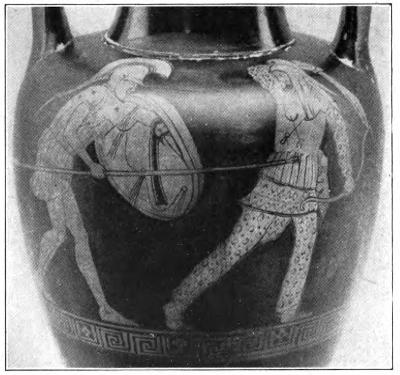
FIG. 104. PERSIAN FIGHTING WITH A MACHAIRA
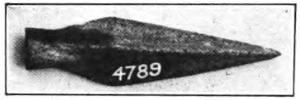
FIG. 105. JAVELIN-HEAD

FIG. 106. SPEAR-HEAD

FIG. 107. DAGGER-BLADE WITH HOOKED TANG

FIG. 108. LEAF-SHAPED DAGGER-BLADE

FIG. 109. BRONZE SWORD
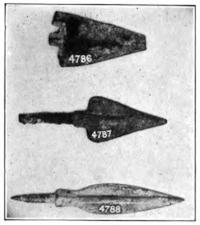
FIG. 110. ARROW-HEADS
Shields were a necessary part of the defensive armor of ancient times, but remains of them are very scanty. Scenes of arming and of combat, however, are so frequent in Greek and Roman art that we are acquainted with their general appearance. Greek shields were usually circular or oval in shape, and made of wooden frames covered with hides and reinforced with bronze. The rim and a large boss in the center were the most essential metal parts, but the entire surface might be covered with bronze, or plates of various forms arranged upon it. The large bronze plates in Case 5 and in Case B in the Second Room seem to have been parts of shields. When using the shield as a defense the warrior thrust his left arm through the Loops in the inside, one of which was close to the rim at the left and another usually near the center of the shield; he held a third, which probably was stouter than the others, in his hand. The loops on the rim are shown in a painting on the amphora which stands on the pedestal in the Fifth Room, as well as the strap extending from side to side by which it was suspended around the wearer’s neck on the march (fig. 103). The Dodona warrior carries the so-called Boeotian shield which has depressions in the middle of each side. Various explanations are given of the origin of this form; a probable one is that it results from stretching a hide over an oval frame on which the top and bottom were fastened firmly while the sides were left free and were naturally drawn in by the pull from both ends. Another possibility is that the shield was cut out at the sides to provide peep-holes. Roman shields were rectangular and curved around at the sides to protect the wearer’s body. Only the boss and the rim were made of metal. The shield of the Greek soldier bore the device of his state, as the Koppa of Corinth, which was painted on the shields of her citizen-warriors; and the Roman soldier carried the sign of his legion in the same fashion. Interesting devices, frequently animals’ heads, were adopted like coats of arms[85] by Greek nobles, and many of these can be seen on vases of the sixth century. An amphora on the bottom of Case 4 shows shields decorated with the heads of a bull and a boar.
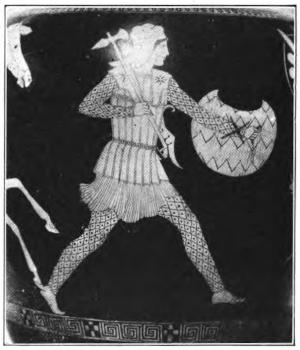
FIG. 111. AMAZON WITH BATTLE-AXE AND WICKER SHIELD
The ancient warrior’s weapons were the dagger, sword, spear, javelin, bow, and sling. The weapons in the Classical Collection cannot strictly be called Greek or Roman because they were made at a remote period before the Greek and Roman states came into existence, but they are interesting in that they show the types from which later weapons were developed, and often there is very little difference between the early types and their descendants. The oldest cutting weapons are the bronze dagger-blades from Cyprus, and those from Crete in Case D 2 in the First Room. They were fitted into wooden or bone handles. A Cretan dagger-blade with an engraved design still holds the three dowels which fastened the haft. The tangs of the Cypriote blades are prolonged or hooked to prevent the blade from loosening in its socket (figs. 107-108). Spear-heads also were at first made to be inserted in the shaft, but later fitted over it. They have a slit on one side of the socket, probably to give elasticity (figs. 105-106). The bronze butt-spikes were used to fix the spear in the ground during halts. Examples of these[86] weapons are in Case 4 and the wall-cases in the corridor.
The swords in the collection date from the Bronze or early Iron Age and so are pre-classical. The fine bronze sword (Case 4, No. 1460) belongs to an early Italian type (fig. 109), and the sword and sheath (No. 1461 in Case A in the Second Room) is also Italian. An iron sword from Cyprus (No. 1462 in the corridor) preserves the form of the bronze swords of the late Mycenaean period, as the early iron-workers at first imitated the shapes of bronze weapons. The pin in the shape of a sword illustrates the type in use during the fifth century in Greece (Case 4). The machaira which Xenophon often mentions had a curved blade and was especially useful as a cutting weapon for cavalry. A good illustration of this shape may be seen in a painting on an amphora in Case N in the Fourth Room representing a Greek and a Persian fighting. The Persian holds a machaira ready for the down-stroke (fig. 104). Roman swords were broad and flat. They were designed for thrusting, and were carried by common soldiers and officers.
The foot-soldier wearing helmet, cuirass, and greaves, and armed with sword, spear, and shield, that is, the familiar hoplite and legionary, formed the most important part of the Greek and Roman armies. Cavalry and light-armed infantry, however, who used the javelin, the bow, or the sling, became gradually more prominent as their importance was perceived in the wars with Eastern peoples and barbarous tribes. The use of the bow and the sling was taught in the palaistra at Athens, as a practical training for warfare, but ability in this direction was not rated very highly. Certain nations were especially skilful with these weapons and served as mercenaries to other states; both Xenophon and Caesar mention the Cretan archers, and Caesar speaks of slingers from the Balearic Isles who[87] served under him in Gaul. The arrow-heads exhibited are Cypriote, but No. 4786 is Hellenic in type (Case 4, fig. 110).
Greek artists frequently represented the Amazons of legend in a dress similar to that of the Persians of their own day, and from such paintings on vases in the collection we find illustrations of various articles of dress and of weapons mentioned by Xenophon. On a polychrome lekythos in Case M in the Fourth Room is an Amazon shooting with a sling. Two spears are stuck in the ground beside her. An oinochoë in Case K in the Fifth Room shows three Amazons in their long trousers and tight-fitting sleeves covered with a pattern. One of them carries a battle-axe and two hold shields of plaited wicker-work, probably of the same sort as those which furnished fuel to cook the Greek soldiers’ breakfast on the morning after the battle of Cunaxa (Anabasis II, 1, 6) (fig. 111). Two large kraters in the Fourth Room decorated with combats of Greeks and Amazons show costumes and arms of the same type and a war chariot of the kind used by the Greeks.
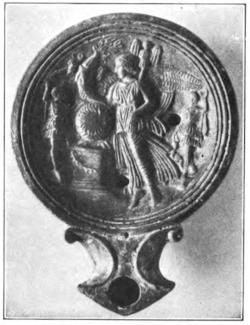
FIG. 112. LAMP. VICTORY WITH A TROPHY
An interesting custom was that of setting up a trophy after a victory; a tree-trunk to which a cross-piece had been fastened was arrayed in armor taken from the battle-field, and remained standing there until destroyed by time or taken by the enemy. A terracotta lamp from Cyprus in[88] Case 5 is decorated with a symbolic device representing Victory holding a trophy at an altar between two Lares militares, the protecting deities of the Roman state (fig. 112).
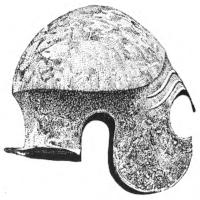
The strength, agility, and symmetry of the body were valued in the highest degree by the Greeks, and with them physical training occupied a much larger place than has been the case among other peoples. Athletics were closely connected with religion, since contests were held as a part of the funeral and memorial rites of heroes, and likewise of the worship of the gods. They also had an important practical end; Greek armies were always levies of citizens, and since there was no considerable length of time during which the Greek states were at peace before the period of Roman domination, the safety of the state depended to a great extent upon the training of its citizens. Gymnastic games and exercises were continued throughout the greater part of a man’s life, contributing to good health and physical development no less than to recreation.
This interest in athletics can be traced back to very early times in the Boxer Vase from Crete dated in the sixteenth century B.C. (a reproduction of this vase is in Case J in the First Room) and the scenes of bull-leaping and[90] the ivory leapers from Knossos (reproductions on the south wall of the First Room and in Case H 2). The Homeric poems contain many references to athletics, as the funeral games of Patroklos in the Twenty-third Book of the Iliad, the games among the Phaeacians in which Odysseus took part (Odyssey VII), and Odysseus’ encounter with the beggar (Odyssey XVIII, vv. 15ff.); but at this time sports were unorganized and no rules had as yet been devised for them. The seventh century was especially the period of organization during which the great festivals became fixed in time and in the number and kind of contests, and by 570 B.C. the four great Panhellenic festivals—the Olympian, the Pythian, the Isthmian, and the Nemean—were established.
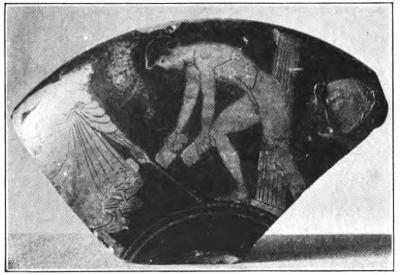
FIG. 113. JUMPER WITH HALTERES

FIG. 114. DISKOS-THROWER
There are a large number of vases, especially those of the late sixth and early fifth centuries, ornamented with scenes from the wrestling-schools and gymnasia. The place is indicated by the objects hung on the walls, such as jumping-weights, a diskos, or an oil-flask and a strigil for removing sand and oil. The trainer is usually present, represented as a mature man, wearing a himation and carrying a forked rod. The flute-player in a long, spotted robe often accompanies the exercises or plays for the jumper.
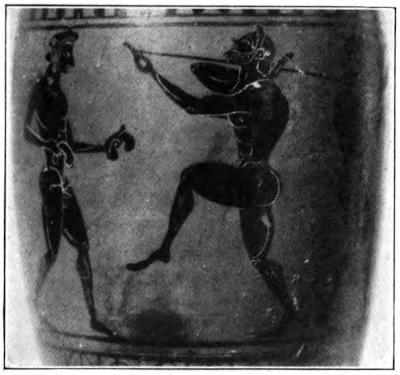
FIG. 115. ATHLETE THROWING A JAVELIN
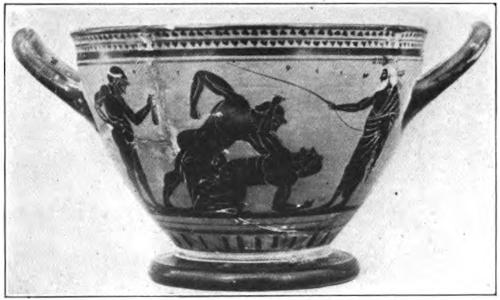
FIG. 116. WRESTLERS
The principal athletic contests were foot-races of various distances, including the torch-race, which corresponded to the modern relay race, broad jumping, throwing the diskos and the javelin, wrestling, and boxing. There were also the pentathlon (five contests), which consisted of the jump, the foot-race, throwing the diskos and the javelin,[93] and wrestling; and the pankration, a combination of wrestling and boxing.
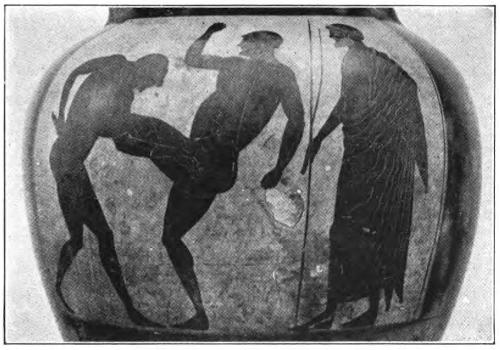
FIG. 117. SCENE FROM THE PANKRATION
For jumping, weights called halteres were used; on the black-figured lekythos on the middle shelf of Case 4 decorated with a scene of athletes practising, two of the number hold halteres, the drawing being sufficiently detailed to show the shape well. On the psykter and a vase fragment on the same shelf are jumpers at the take-off (fig. 113), and a boy preparing for a jump decorates the interior of a kylix on the lower shelf in Case P in the Fifth Room.
A foot-race is represented on one of the Panathenaic amphorai in the Third Room (Case N), and the cast of a bronze statuette in Tübingen shows a contestant in the race for hoplites (heavy-armed foot-soldiers), at the starting-line (top shelf of Case 3). The shield which he carried on his left arm has been broken away.
Throwing the diskos was one of the oldest Greek sports. The object was to throw it as far as possible, as in putting the shot. So many representations of this sport have come down to us in statues, vase paintings, coins, and gems,[94] that it is possible to work out the successive movements of the throw. The principle seems to have been always the same, though individuals were allowed certain differences in style. A bronze statuette in Case B in the Fourth Room (fig. 114) shows one stance; the athlete is about to swing the diskos down from the left to the right hand. The position preliminary to the swing downwards to the side, the athlete now holding the diskos in both hands, may be seen on the lekythos in Case 4; and one of the figures on the psykter is in the same position. The well-known statue by Myron, of which a cast stands in Gallery 22, shows the position just preliminary to the throw, an instant before the diskos leaves the hand.
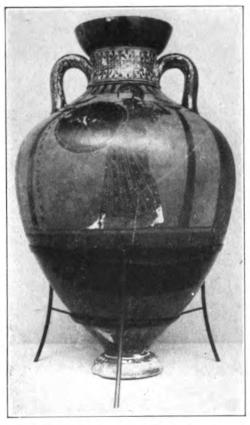
FIG. 118. PANATHENAIC AMPHORA
The art of fighting in heavy armor, hoplomachy, was taught to Greek boys by a special master as part of their athletic training. A most interesting scene of this kind decorates the shoulder of a hydria of the late sixth or early fifth century where two men armed with helmet and shield are fencing with spears to the music of a flute-player (Case Y in the Fourth Room). Plato alludes more than once to the attention given to this branch of physical training in his day, and the prestige enjoyed by teachers of the art.
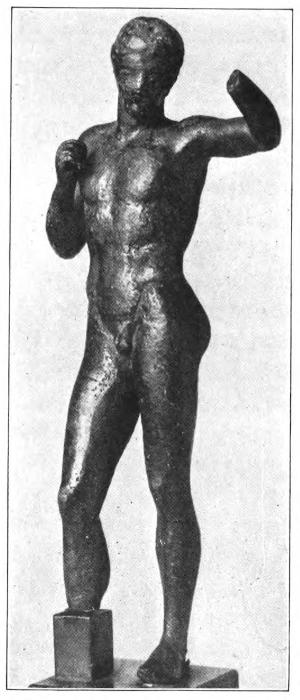
FIG. 119. YOUTH BINDING ON A FILLET
Throwing the javelin also had a practical value as preparation for warfare and was one of the commonest sports of the palaistra. In the pentathlon it was thrown for distance only, but there were competitions in throwing at a target at the Panathenaea and, no doubt, on other occasions. A thong, fastened near the center of gravity, and twisted around the hardwood shaft, acted like the rifling of a gun in insuring greater accuracy. One of the figures on the black-figured lekythos is preparing to throw a javelin, and the artist has represented the thong in such a way that the method of using it can easily be understood. The thrower holds the shaft in his hand with the first and second fingers inserted into loops in the end of the thong. As he throws, the thong unwinds, giving the missile a whirling motion (fig. 115).
The use of the bow and the sling, as has been said in the section on Armor, was also taught in the palaistra at Athens.
The pankration, a combination of wrestling and boxing, was one of the most popular Greek sports. In it ground-wrestling and hitting were allowed. Two scenes from the pankration are represented on a skyphos in Case 4. On one side the winner has thrown his opponent backward and is about to strike him, while the other holds up his hand, probably as a signal of defeat (fig. 116). On the other side the combatants have their hands covered with the thongs which served as boxing-gloves. The man on the ground has thrown the other by a neck-hold (see head-band, p. 89). There are two boxers in the group of athletes on a krater on the top shelf of Case Q in the Fifth Room, and a boxing scene is represented on one of the Panathenaic amphorai.
The value of the prizes given for athletic skill varied greatly, from the wreath of olive at Olympia and the parsley leaves of Nemea to articles of considerable value and, in a few cases, even money. At the Panathenaea the[97] prizes were jars of oil in greater or less numbers, and the painted vases known as Panathenaic amphorai. Probably only one of these was given to a victor. They bear on one side a picture of the contest in which the vase was won, and on the other, the figure of Athena with an inscription, “From the games at Athens” (fig. 118). When the prize took the form of a wreath, the victor first bound a fillet or band of wool around his head and upon this the official in charge of the games placed the wreath. The act of tying the fillet was often represented by Greek sculptors; the most famous example is, of course, the Polykleitan statue known as the Diadoumenos, of which a cast stands in Gallery 22. The beautiful bronze statuette in Case D in the Sixth Room has the same motive (fig. 119), and on the psykter in Case 4 a boy who holds in his hands the palms signifying victory is being crowned by an official.
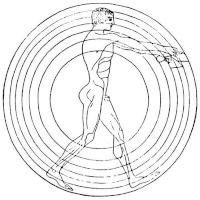
In the Homeric period cavalry was not employed in battle, but princes and nobles drove about the field in chariots from which they descended to fight. The bodies of these chariots were just large enough for the warrior and his driver to stand side by side, since lightness and quickness of movement were essential. The chariot in the Third Room (fig. 120) is of the type in use among the Etruscans; the Greek type in the earliest pictures which we have is more open and slightly different in shape. An excellent representation of the Greek chariot may be seen on a large amphora on Pedestal R 3 in the same room, and this drawing also shows the light harness in use and the method of arranging it. War-chariots were used on occasion for racing, as at the funeral games of Patroklos in the Twenty-third Book of the Iliad; and at a later period, when nobles no longer rode to battle and armies of citizens were the rule in Greece, the chariot remained as a racing vehicle. The principal feature of the Olympic games from the year 680 B.C. was the chariot race for four horses, and a victory in this event brought much-coveted renown to the owner of the horses and his city. The Greeks of Italy and Sicily were devoted to this sport, their interest being reflected in their coin types, of which the finest are the Syracusan (fig. 121). Some examples will be found in the Ward Collection in the Gold Room.
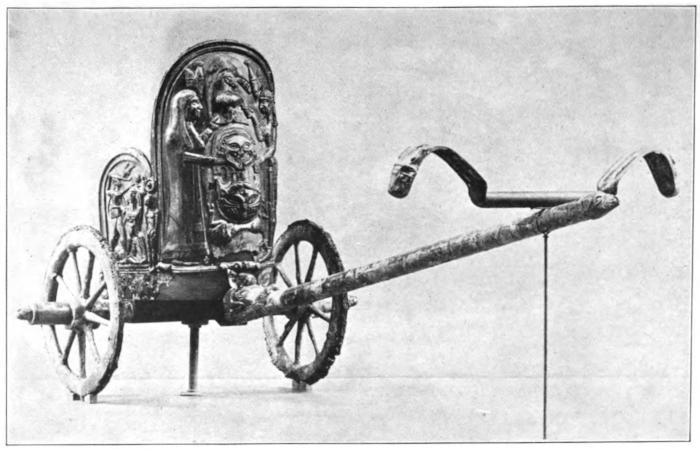
FIG. 120. BRONZE CHARIOT
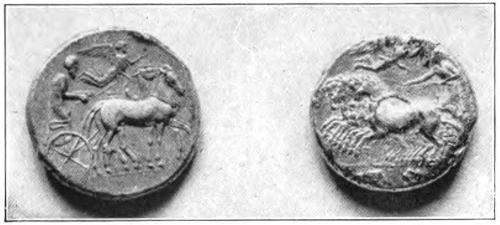
FIG. 121. RACING CARS ON SYRACUSAN COINS
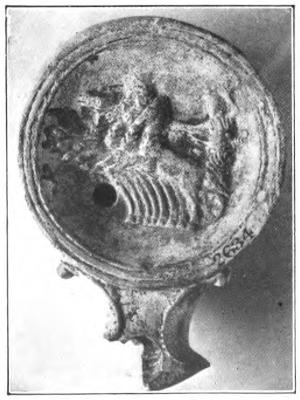
FIG. 122. LAMP. SCENE FROM THE CIRCUS
A very beautiful bronze statue found at Delphi, no doubt a dedication after a victory, represents a young charioteer in the long white chiton which was his traditional dress (Cast No. 462 in Gallery 22), and a fragment of[101] a relief from the Mausoleum (Cast No. 741 on the east wall of Gallery 25) shows another with flying hair and garment as he strains forward toward the goal. One of the Panathenaic amphorai in the Third Room was a prize in a chariot race at Athens, as we know from the drawing on one side (fig. 123). Another event in the games at Athens was a race for two horses harnessed to a little cart in which the driver sat, but this contest was never so important as the race for four horses. At other games the chariot was the vehicle used for two horses as well as for four. These sports were naturally very costly, and under the Roman rule they gradually died out in Greece as races in the circus in Rome and other Italian cities took their place. Chariot races were the earliest of the free shows at Rome and were always the most popular, the great attraction of the circus being not the speed of the race, but its danger. Some clay lamps from Cyprus are decorated with reliefs of chariots and horses, showing how the passion for racing spread over the Roman world (Case 5, fig. 122).
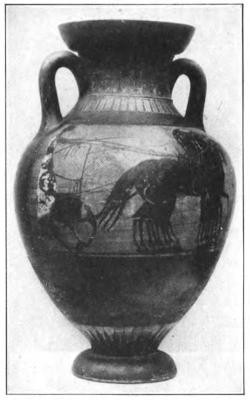
FIG. 123. PANATHENAIC AMPHORA CHARIOT RACE
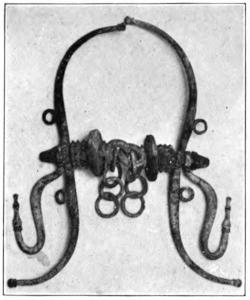
FIG. 124. BIT USED IN TRAINING HORSES
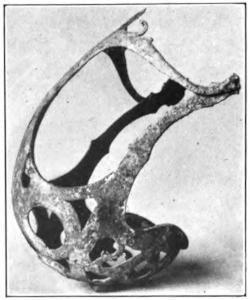
FIG. 125. HORSE’S MUZZLE
Riding was the usual mode of travel in Greece, as it is still in many parts of that mountainous country; and, while carts and carriages of various kinds gradually came into service among the Romans, in Italy, too, the horse was[102] the commonest means of travel. But although the Greeks and Romans were good horsemen, they were probably not the equals of the best modern riders, owing to the fact that they had no saddles and no stirrups. As a result of the absence of stirrups, able-bodied persons mounted with the help of a spear or staff, while old men were handed up by slaves. Women rode only upon a pillion, and probably not very often in that way. The custom of nailing metal shoes upon the hoofs of horses was not known, but shoes made of metal, leather, or rushes were adjusted before passing over a specially bad road, and could later be removed when no longer needed. Two bits are shown on the bottom of Case 4. One is quite simple, consisting of two bars joined by a double link, which probably belongs to the sixth century, though no doubt this type was in use for a long period (fig. 127); the other, probably of the fifth or fourth century, is very severe. Xenophon in his treatise on Horsemanship (X, 6) describes this variety and[104] explains its use in training horses (fig. 124). Branding was practised even for valuable animals. On a small amphora in Case C in the Fifth Room decorated with a picture of the Sun in his chariot, one of the horses is branded with a sun surrounded by rays. It was customary to muzzle horses when they were taken out for exercise or for some other purpose without a bridle. Probably the muzzles were usually made of leather, but bronze was employed on special occasions or by the wealthy. Two bronze muzzles, one of a simple, the other of a more elaborate form, are exhibited (Case 4, fig. 125).

FIG. 126. YOUNG HORSEMAN
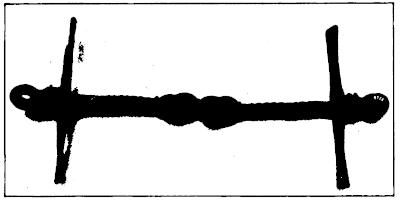
FIG. 127. BRONZE BIT
Greek boys received lessons in riding in the course of their athletic training, which was, of course, a preliminary military training as well. In Attica a troop of ephebes, young men in military service, patrolled the borders as a mounted guard. The decoration on a krater in Case P in the Fifth Room and a relief in Case A in the Sixth Room represent members of this troop in their short cloaks fastened on the shoulder and their broad-brimmed hats. The fine relief, No. 13 in the Sculpture Gallery, also represents an ephebe (fig. 126) or one of the Diaskouri in this guise. Hunting deer and boars from horseback was a favorite sport which required skill in the rider, and riding-races of various types were a feature of the games. One of[105] the Panathenaic amphorai was a prize for a horse-race at Athens, as the decoration shows.
The bronze statuette of a horse at the head of the main staircase allows us to see the type of animal bred in Greece, and is at the same time a work of the greatest spirit and delicacy.
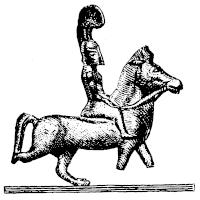
Combats of gladiators formed part of the funeral rites of the Etruscans, and in Campania they were offered as entertainment to guests at feasts. The Romans adopted the custom from their neighbors, the first public show of gladiators taking place in 264 B.C. For six centuries they continued to be a favorite amusement in Italy and the provinces, until Honorius made them illegal in 404 A.D. The great popularity of the sport is proved by the frequency with which it was represented on articles of common use, such as vases, dishes, lamps, seal-rings, and in sculpture, mosaic, and painting for the decoration of walls.
In early times the combatants were prisoners of war who fought with their own arms and equipment for the entertainment of their conquerors, and later, when men were recruited in other ways, the arms of the early enemies of Rome were in a great measure retained as belonging especially to this sport. Gladiators received a careful training in schools kept for the purpose. They were divided into several classes, according to their weapons and manner[107] of fighting, and were called by the name of the peoples whose arms they had adopted. They usually fought in pairs, each from a different class, though occasionally a number engaged in a mêlée. The most important class was the Samnites, who wore a helmet, one greave, a guard on the right arm, and fought with sword and shield. The lamps from Cyprus in Case 5, Nos. 2639, 2642, 2643, are decorated with figures of Samnites in relief (fig. 128). The Thracian was distinguished by a dagger which was curved or bent at right angles. He wore two greaves with leather coverings for the thighs, and an arm-guard, and carried a little shield (lamp No. 2636, fig. 129). The hoplomachus seems to have been a variety of Samnite who had a large shield, and was generally paired with the Thracian (lamp No. 2637, see tail-piece, p. 108). Another class not illustrated was the retiarius (net-thrower), equipped with a dagger, a trident, and a large net in which he tried to envelop his adversary, the secutor (follower), who was armed like a Samnite.
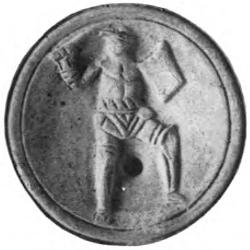
FIG. 128. SAMNITE GLADIATOR
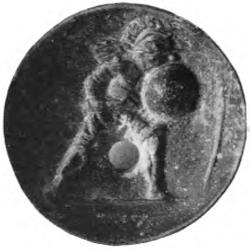
FIG. 129. THRACIAN GLADIATOR
A combat between a Samnite and a Thracian decorates one of the lamps (No. 2641). Another (No. 2647) shows a wounded Samnite on one knee. On a third (No. 2644)[108] a Thracian has brought his opponent to the ground, and by holding up his thumb, seems to signify that he will spare him, or perhaps asks permission of the spectators to do so. A fourth lamp (No. 2651) is decorated with two swords and two pairs of greaves. Four gladiatorial combats appear in relief upon a glass cup, made in Gaul in the second century A.D., which is on the top shelf of Case 3 (see head-band, p. 106). The names of the combatants are placed over their heads, so we may suppose that they represent actual gladiators who were famous in their day. Gamus, a Samnite, stands over Merops, who is lying on the ground and holding up his thumb to ask mercy from the spectators. Next come Calamus, a Samnite, paired with Hermes, a Thracian, then another pair of Samnite and Thracian, Tetraites and Prudes. The latter has lost his little shield. In the fourth combat Spiculus is victorious over Columbus.
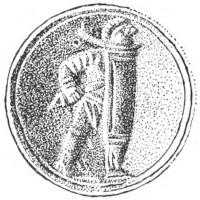
In this division is assembled a series of miscellaneous objects illustrating trades and crafts, political life, agriculture, and other occupations.
The processes of agriculture and craftsmanship in Greece and Italy were much like those of Europe and America a century ago, before mechanical devices became common. Cultivation of grains, the olive, and the grape has been practised in Aegean lands from prehistoric times. A bronze farmyard group in Case 3 shows the animals and utensils most necessary to a farmer, and though Roman, will serve as an illustration of Greek life as well. The animals include two bulls, two cows, a pig and a sow, a ram and a ewe (fig. 130). There are also two double yokes, a cart, and a plough. The plough-tail has been lost, but a hole shows the place of attachment. The remainder is in one piece, though the joints of the rude wooden original are carefully represented, the pole which is fastened to the yoke being attached to[110] the share-beam by pegs and the share-beam to the share by thongs or ropes. This primitive wooden plough is still used in Greece today (fig. 131). The cart is merely a platform with a front-board and tail-board, mounted on solid wheels. A terracotta cart from Cyprus, though of the early Iron Age, is much like the Roman cart (fig. 132). A small bronze sickle with indented edge from Cyprus belongs to a type common in Minoan Crete (Case 5). The bronze shepherd’s crooks in the same case recall the important place held by the care of sheep and goats in ancient country life. A stone model of a sheep-fold in Case 40 in the Cesnola Collection, containing sheep and a drinking-trough, was intended as a votive offering, probably for increase of flocks.
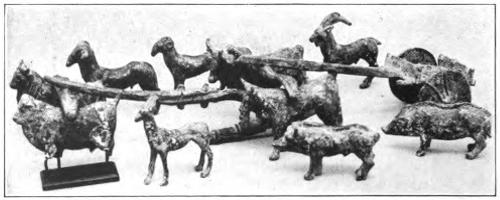
FIG. 130. BRONZE FARMYARD GROUP
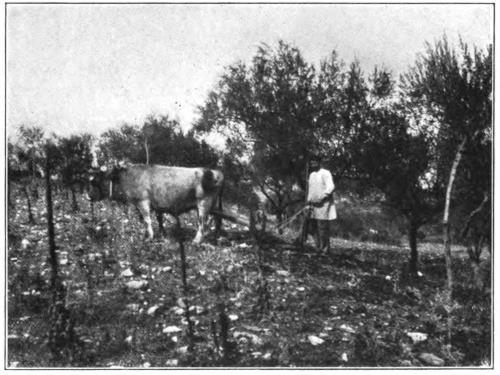
FIG. 131. GREEK FARMER PLOUGHING
The cultivation of the vine and wine-making for domestic use were a part of the yearly routine on the farms of Greece and Italy, while the finer kinds of wine were a valuable article of commerce. The only object in the collection which illustrates wine-making is an Arretine bowl in Case G2 in the Eighth Room, decorated with figures of satyrs gathering and treading grapes. The process of getting rural produce to market is represented by two terracotta figures of donkeys with panniers whose counterparts can be seen in Greece at the present day (figs. 133-134).[111] The conformation of Greece and Italy, and the numerous islands of the Mediterranean compelled the inhabitants to accustom themselves to seafaring from the earliest times. A vase painting and some clay boats from Cyprus are valuable illustrations of the type of ship in use in the sixth century. A black-figured krater of that date in Case 1 has three long boats or war vessels painted inside the mouth. These vessels were propelled by oars, as the method of fighting made speed essential to them, though a sail was used when the wind was favorable. Two of the ships have eleven oars on a side, and the third has nine. The steersman sits in the stern with one or two steering paddles. The forecastle is surmounted by a high stem-post, and between the stern and the forecastle runs a railing or bulwark. The bow projects in the form of an animal’s head, probably a fish or a boar, and a large eye is painted just above the water-line. The edge of the krater has been injured so[112] that the sail has disappeared, but the single mast can be seen, as well as the sheets and halyards. A ship of this kind regularly has a square sail and halyards, brailing-ropes, braces, and sheets. Above the stern projects an ornament rather like the tail of a bird. It was this that was taken by the enemy as a trophy (fig. 138). The clay boats from Cyprus in the same case are of a type frequently found in sixth-century graves in Amathus. Two of them represent merchant vessels, as is shown by their breadth and deep hulls. The largest has strakes along the water-line which held the “under-girding” of ropes used to prevent the planks from springing in stormy weather, and large cat-heads at the bows to receive the anchor. The helmsman sits in the stern with his two steering-oars. Of the two other boats the smallest is a row-boat, and the other has a deck and a small deck-house (fig. 139).
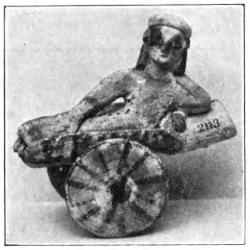
FIG. 132. TERRACOTTA MODEL OF A CART
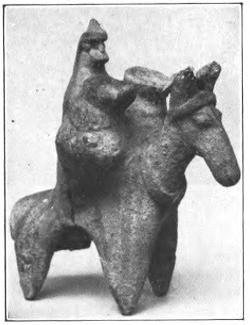
FIG. 133. TERRACOTTA FROM CYPRUS. DONKEY WITH PANNIERS
A rude relief on a stone slab from Cyprus (Case 1) is a votive offering for rescue from an accident in quarrying or mining. Above is Apollo seated before an altar. Below, a man is hastening to help another who is standing in front of a large mass of rock or earth. Between them a pickaxe[113] lies on the ground. Probably the relief represents a dangerous fall of rock or earth. The inscription runs: “Diithemis dedicated it to the god Apollo, in good fortune.”
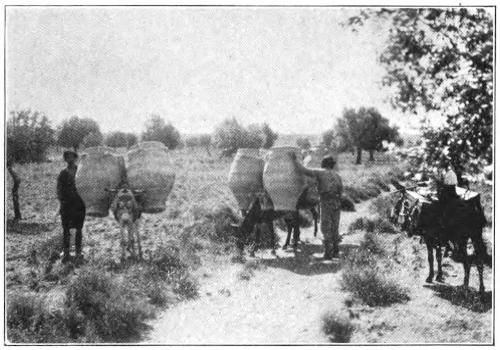
FIG. 134. DONKEYS CARRYING JARS IN PANNIERS, 1922
Very few wooden objects have survived from ancient times, but examples of the tools used in making them and of metal fittings remain. The axe-blades from Cyprus in Case 5 and in wall-cases in the corridor are of almost pure copper. These blades were inserted in a haft or lashed to a handle. In Case B in the First Room are four double axes from Crete of the second millennium B.C., and in Case A in the Fifth Room another of much later date. Handles were inserted between the two blades, as in the modern hammer. The chisels, awl, nails, and hinges in Case 5 are Cypriote. In Case B in the First Room are chisels and an awl, and in Case D 2 several knives, from Crete. They are especially interesting in that they are well preserved and of excellent workmanship.
The keys exhibited in Case 5 (figs. 135 and 137) are of three types. The earlier one is shown with the bolt to which[114] it belongs. The key when inserted into the bolt pushed upward with its teeth a series of pegs which fitted into holes in the bolt and took their place. It could then be used as a handle to pull the bolt backward. The second consists of a plate provided with notches which lifted a series of tumblers and allowed the bolt to be shot. The third key belongs to the type in use today, and as such keys have been found in Pompeii, they must have been known before 79 A.D. The lock-plate is perhaps from a strong-box (fig. 136).

FIG. 135. KEY EARLY TYPE
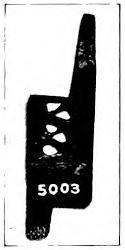
FIG. 136. LOCK-PLATE
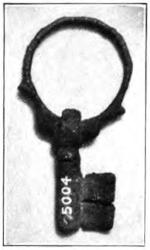
FIG. 137. KEY LATER TYPE
Only the balance seems to have been known to the Greeks, but the Romans made use of the steelyard also. The example shown in Case 1 does not differ from those of modern times. The hooks and chains at the end of the rod were used for suspending the articles to be weighed. Three other hooks, of which two are preserved on movable rings, were for hanging the steelyard. Each is attached to a different side. When the steelyard was hung by the hook nearest to the graduated bar, articles up to twelve pounds could be weighed by sliding the weights along the bar. The second side of the bar weighs articles of from five pounds to twenty-two; the third, articles of from twenty to fifty-eight pounds. The large weight is made of lead[115] covered with bronze, and weighs two pounds, while the small weight is entirely of bronze and weighs one ounce (see head-band, p. 109.)

FIG. 138. WAR-VESSELS. VASE PAINTING

FIG. 139. TERRACOTTA BOAT
There are a number of objects illustrating various industrial processes in the collection. A fragment of a pottery cup of the red-figured technique shows the stage at which the figure is outlined with a broad band of black paint, in order to make a red silhouette, but the background has not yet been filled in with black (fig. 141). Several moulds for making terracotta reliefs are shown with modern impressions made from them; they represent the lower part of a young man’s figure (Case A in the Fifth Room, fig. 142), a grotesque of a man, a Medusa[116] head, and a number of symbols, perhaps for stamping sacred cakes. Another mould, unfortunately fragmentary, is a chimaera or a goat, a fine and spirited figure (Case B in the Seventh Room). In Cases C and G2 in the Eighth Room are examples of Arretine ware, the most beautiful pottery of ancient Italy. There are also ancient moulds with modern bowls made from them. Several of the moulds are signed by the makers and by the owner of the workshop. A small stone mould for casting gold ornaments of the Late Minoan period is in Case B in the First Room. It has two dies representing animals, one a bull and the other probably an ibex. The gold-beater’s block in Case 5 was used for making small ornaments when many of the same kind were needed. A thin sheet of metal was laid on the die, covered with wax or lead, and then beaten into the die with a hammer. There are twenty-two dies on this block belonging in style to the Roman period. Some gold ornaments used for borders among the Roman jewelry in the Gold Room were probably made in this way, but such mechanical devices do not seem to have been employed in making Greek jewelry of the best period (fig. 140).
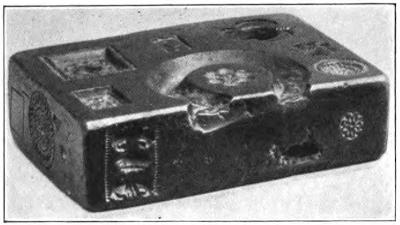
FIG. 140. GOLD-BEATER’S BLOCK
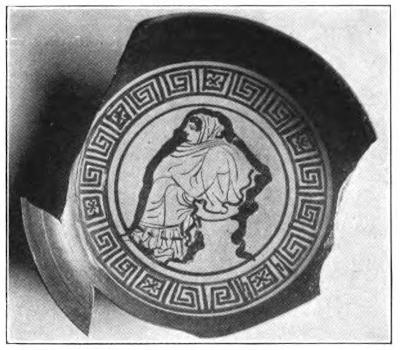
FIG. 141. UNFINISHED POTTERY CUP
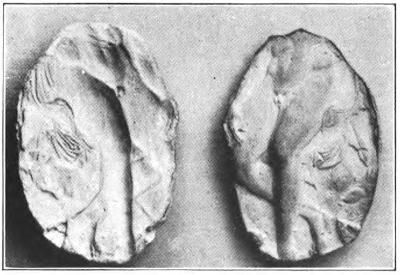
FIG. 142. ANCIENT MOULD AND MODERN RELIEF
The earliest traders of the Mediterranean lands practised barter, and in the Homeric poems we find cattle and bronze utensils frequently mentioned as standards of value. In the later part of the eighth century or the early part of the seventh, coinage originated in Asia Minor, the[117] earliest coins being merely rough lumps of metal with striations on the reverse made by the roughened surface of a punch. In the process of manufacture a flat blank of metal was placed red hot on a die, a punch was then held upon the reverse of the blank, and struck with a hammer. As no “collar” was employed, the metal of course spread at the edges, making the coin only roughly circular. With the advance of art the coin types received the attention of the best artists and craftsmen, and in consequence the value of Greek coins, both as original works of art and as[118] historical documents, cannot be exaggerated. Roman coins, while not often beautiful, are an important source of information relative to political and economic conditions. These facts may be noted with regard to the practical side of ancient coinage; Greek coins are not dated, they will not stack, and marks of value are more often absent than present. The earlier Roman coins resembled the Greek in these features, but, later, marks of value were added and the date indicated.

FIG. 143. DIKAST’S TICKET
A number of small bronze instruments in Case 5 may have been part of a physician’s or pharmacist’s case. They include several probes, one being double (fig. 144), spatulae (fig. 145), spoon-probes, and two scalpels or bistouries. The spatulae were used for preparing and spreading ointments, and also by painters in mixing colors.
The dikast’s ticket gives us a glimpse of Greek city life. It is the ticket of a juryman, Epikrates, entitling him to sit in the ninth court at Athens, of which there were ten in all, and to draw three obols a day, about ten cents, a “living wage,” however (fig. 143).
The statuette of a negro boy in Case C in the Seventh Room is a reminder of the important part taken by slave labor in ancient times. This was much greater among the Romans than in Greece. Slaves were sometimes captives taken in war, or their descendants, but were more frequently acquired through trade. Their condition was much better in Greece than in Rome. On the grave stele[119] of a young man in the Sculpture Gallery (No. 7) a little slave stands beside his master.

FIG. 144. FORKED PROBE
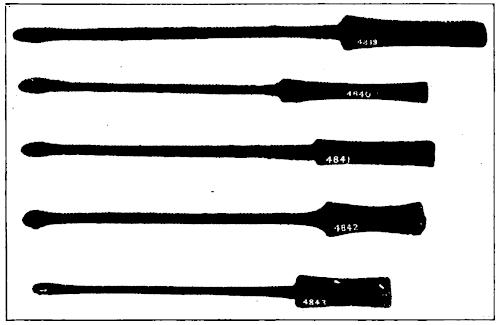
FIG. 145. SPATULAE
These are, of course, domestic or personal servants, but slaves formed a large part of the laboring class in Greece, and the proportion was still greater in Rome in the later Republican period and under the Empire. They worked on the farms, in the factories, and, most dangerous occupation of all, in the mines and quarries, as well as in the workshops of skilled artisans and as clerks and copyists in private and public offices.
There are many proofs of the existence of an extended and active commerce in the Mediterranean world, but none is more convincing than to note the far-distant places in which Athenian pottery has been found. The cities and tombs of Italy have furnished many of the most[120] beautiful specimens, but vases have been found in Asia Minor, Egypt, the islands of the Aegean, and the Crimea. A specimen of ancient advertising appears on three glass cups signed by the maker Ennion, a Sidonian (Case H in the Eighth Room). One was found in Cyprus, a second near Venice, and a third near Nazareth. Each bears the maker’s signature and the words, “Let the buyer remember.”
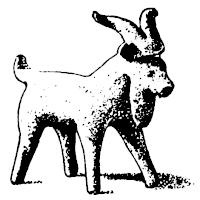
Greece. The inhabitants of Mycenae and other prehistoric sites did not burn their dead, so far as we know, but buried them with the belongings which they had used and valued in life. Members of rich or princely families were often decked with gold ornaments and diadems, and the face covered with a gold mask moulded to resemble the features. Reproductions of some of the objects found in graves at Mycenae are in Case T in the First Room, and in the center of the same room is a reproduction of a stone sarcophagus from Hagia Triada in Crete, decorated with painted scenes representing a funerary sacrifice.
The people of the Homeric poems burned their dead and buried the ashes beneath a mound. Both ways of disposing of the body continued in common use in Greece, the choice resting with the family of the deceased. Cremation was more costly than burial, and so was practised less frequently by the poorer classes. At all periods both[122] Greeks and Romans attached great importance to the proper performance of funeral rites, as they were believed to affect the happiness of the soul in the world of the dead.
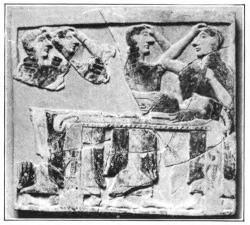
FIG. 146. MOURNERS AT A BIER. TERRACOTTA RELIEF
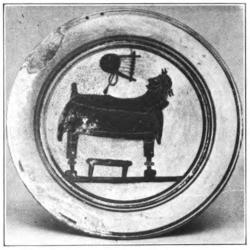
FIG. 147. POET ON HIS BIER (?) TERRACOTTA PLATE
The body was prepared for burial by the women of the family, who anointed it with oil and perfumes, and clothed it in the dress of common life, usually of white. A wreath of flowers, or of laurel, olive, or ivy was placed on the head, or in its stead a wreath of gold leaves. Before the funeral the dead was laid on a couch in the central hall of the house, with his feet toward the house door. His relatives and friends came to pay their last respects, and the funeral dirge was sung. An interesting terracotta relief from Attica on the north wall of the Second Room represents such an occasion. The women standing by the bier are tearing their hair as they raise their voices in the lament (fig. 146). The same scene is frequent on certain kinds of Greek pottery, notably the great Dipylon vases of the eighth century B.C., which were used as grave[124] monuments. There are two Dipylon vases in the Second Room in Cases G and L (fig. 148). On the upper band of each is a scene showing a dead man on a bier surrounded by his family (see head-band, p. 121). An interesting plate in Case K in the same room is decorated with a scene which seems to represent a poet on a funeral couch with a wreath about his head and his lyre hanging on the wall above (fig. 147).
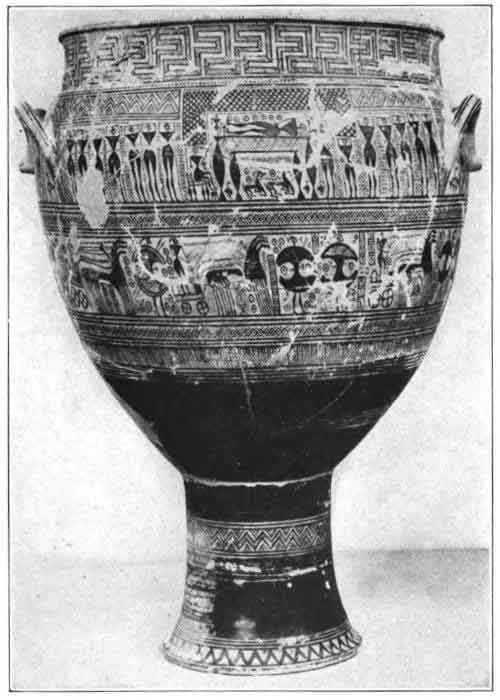
FIG. 148. DIPYLON VASE

FIG. 149. ATHENIAN TOMB LEKYTHOI
The greatest number of funeral scenes are found on the white Athenian lekythoi of the fifth century and later, which were made to be placed about the bier, in the tomb, or around the monument. One of those in Case L in the Fifth Room is painted in colors with a scene of mourners beside a funeral couch, treated in a later style. Other typical scenes are the farewell of the dead to his family as if for a long journey, and the care of[125] the tomb by surviving relatives. Most of the vases in Cases L and F in the Fifth Room are decorated with variations of these two themes (fig. 149). Early in the morning of the second or third day after death the body was carried on the couch out of the city gates for burial or cremation. The funeral procession is represented on the lower bands of the Dipylon vases, or it may be that the horses and chariots are intended to suggest the funeral games, which were celebrated in early times after the death of a man of rank.
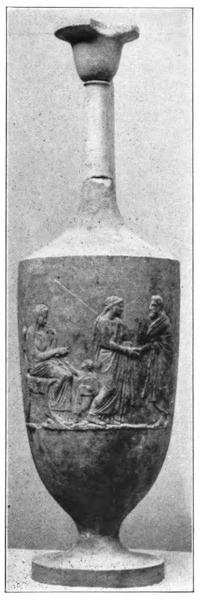
FIG. 150. MARBLE LEKYTHOS
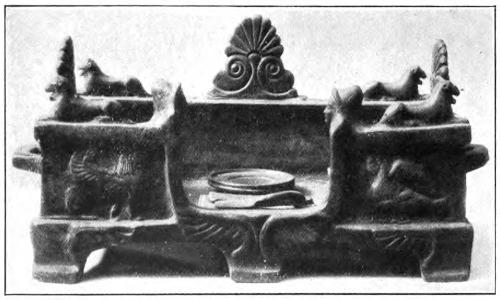
FIG. 151. ETRUSCAN FOCOLARE
The loutrophoros is a vase associated especially with the funeral procession. These long-necked jars were used in the marriage ceremonies to bring water for the ceremonial bath of the bridegroom and the bride; and in the case of the death of a betrothed person, a loutrophoros was carried in the funeral procession and set up on the grave. One of these vases will be found in Case R in the Third Room. If the body was disposed of by cremation the ashes were placed in a jar, usually of stone or pottery. In Cases P, R, and T in the Seventh Room are a number of pottery jars which were used to hold the ashes of Greeks who died at Alexandria. Some of them are marked with the name of[126] the deceased and the position of the jar in the cemetery. It was usual to erect tombs along the roads leading from the city gates, the sculptured tablets bordering the highway on either side, interspersed with trees, and sometimes accompanied by stone seats erected by families for the use of those members who came to tend the graves. Greek grave monuments are frequently very beautiful, and are characterized by fine taste and restraint in the expression of feeling, as well as by the absence of painful or shocking suggestion. There are a number of examples in the Sculpture Gallery. The marble lekythos is an example of a common type of monument (fig. 150). Another form is the lofty tablet with painted or sculptured akroterion (see tail-piece, p. 131), such as Nos. 6 and 5A in the Sculpture Gallery and the stele in the Third Room. Examples of tablets with sculptured figures are Nos. 4, 7, 10, 30, and 59 in the Sculpture Gallery and the stele of a young man in the Sixth Room. On these monuments the dead is represented alone in a quiet pose, with some article or utensil suggesting his favorite occupation or manner of life; or as taking leave of his family (fig. 152). In Rooms[128] 21, 22, and 23 in the Gallery of Casts are reproductions of some of the most beautiful and best known of the Greek grave stelai. Several painted stones from the cemetery near Alexandria will be found in two cases in the Vestibule. The Cesnola Collection contains a number of Cypriote grave monuments inscribed with Greek formulas of farewell. These are in Cases 6 to 12, 14, and 15 in the corridor.
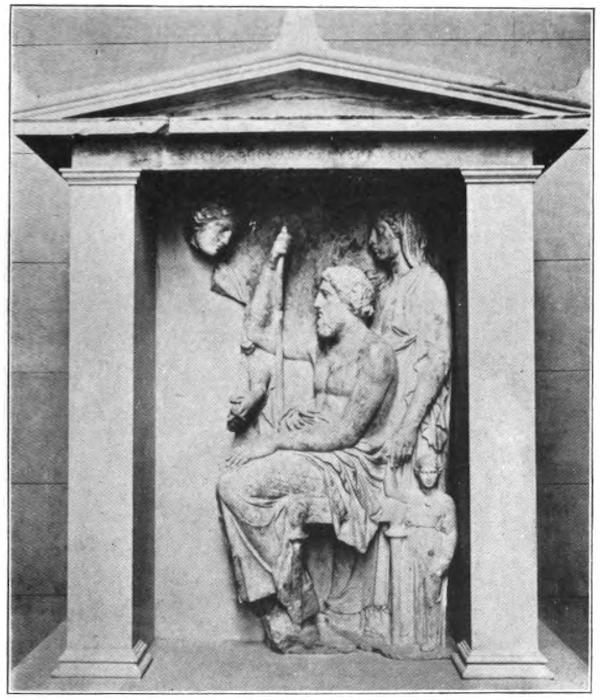
FIG. 152. MONUMENT OF SOSTRATE
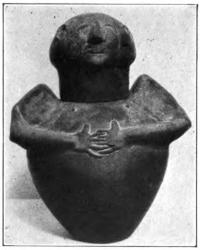
FIG. 153. ETRUSCAN URN FOR ASHES
The custom, followed by the inhabitants of Greece and Italy for many centuries, of placing in tombs articles used in daily life, has preserved large numbers of objects which would otherwise have perished. The dead was surrounded by the belongings he had valued; the warrior had his arms, the woman her ornaments, mirror, and toilet boxes, and the child his toys. An idea of the prevalence of the custom may be formed by looking through the collection with this fact in mind. The greater part of the Greek pottery now in existence was found in tombs, not only in Greece but in Italy and in many other parts of the Mediterranean world. The bronze chariot and the utensils in Case S in the Third Room were the tomb furniture of an Etruscan noble. The beautiful bronze table service in Case E in the same room, and the table service of black-glazed pottery in Case G in the Seventh Room were also found in tombs. In Case F in the Sixth Room are the toilet articles and utensils buried in the grave of an Etruscan lady, the terracotta figurines in the Sixth and Seventh Rooms were made to be placed in graves, and many[129] separate objects in the collection have been preserved in the same manner.
Italy. The earliest inhabitants of Italy did not practise cremation, but this custom was introduced in prehistoric times, both cremation and burial continuing in use contemporaneously.
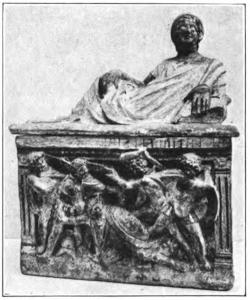
FIG. 154. ETRUSCAN URN
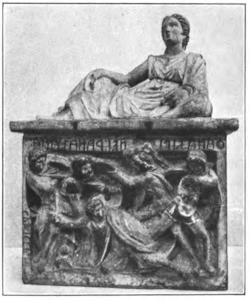
FIG. 155. ETRUSCAN URN
The Etruscans placed the ashes of the dead in jars with smaller vases and ornaments and buried them in pits; or for the wealthy, tomb-chambers were built and arranged to resemble rooms in the houses of the living, the cinerary urns being set in niches, or the bodies being laid out on biers. Their urns in the earlier periods were frequently made in a very rude imitation of a human being with portrait head, and were often placed in terracotta chairs. Two examples are in Case N in the Second Room (fig. 153). Curious trays of dishes, probably used for offerings to the dead and known as “focolari,” are not uncommonly found in tombs. Examples are in Cases R and[130] Q in the Second Room (fig. 151). In later times rectangular stone boxes, sculptured or painted, with a reclining figure of the deceased on the cover, were used. There are several of these urns in the Seventh Room, in Cases N and P and on Pedestals E and U (figs. 154-155).
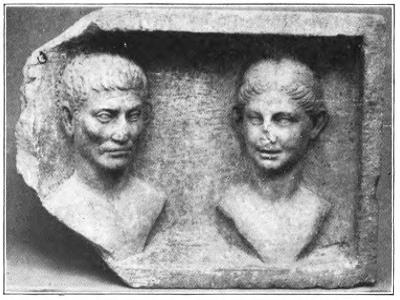
FIG. 156. ROMAN GRAVE MONUMENT
The Romans burned their dead, with some exceptions. A few of the ancient families, notably the Cornelii, kept to the older fashion of burial, and it was customary even when a body was cremated to take one small portion of bone, called the “os resectum” from the ashes and bury it. The very poor, slaves, and outcasts were buried in graves made to hold a number of bodies, often with little care or respect. Roman funeral customs, so far as we know them, were very similar to those of Greece. Glass urns were in common use in the western part of the Roman world from the first to the third century A.D. One still contains fragments of bone and ashes. Under the Empire the custom of burial became frequent among the well-to-do, as is evidenced by the large and costly stone sarcophagi of the period. There are two Roman sarcophagi, Nos. 36 and 46 in the Sculpture Gallery, and a large one from[131] Tarsus in the Vestibule. The relief on the south wall of the Sculpture Gallery representing the death of Meleager (No. 38A) once decorated a sarcophagus. These sculptured scenes are rarely connected with death, but are usually mythical or fanciful. A grave monument on the west wall of the Eighth Room, representing a young man and his wife, is interesting in that this form of portrait relief within a box-like frame is thought to have been derived from the wax death-masks, “imagines,” enclosed in boxes, which adorned the hall of the Roman noble (fig. 156). In the Sculpture Gallery is a stone cippus or monument (No. 43), erected to a mother and her two sons, and decorated with portraits in relief.
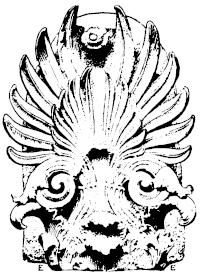
- A
- Actors, costume of tragic, 14;
- in Old Comedy, 14, 16-17;
- in New Comedy, 17;
- of mimes, 17;
- social status of, 17, 18
- Alabastron, 64
- Altar, 4
- Amazon, 87
- Amulet, 8, 40
- Animals, domestic, 109, 110;
- see Pets
- Apoptygma, 48, 49-50
- Apotropaion, see Amulet
- Arrow-Head, 87
- Aryballos, 63-64
- Astragals, 43, 68
- Attis, 11
- Awl, 113
- Axe, die for votive, 5;
- battle-, 87, 113
- B
- Ball, game of, 42-43
- Beard, 56, 58, 62
- Belt, armored, 81-82
- Bit, horse’s, 102, 104
- Boat, 111-112
- Boxing, 89, 92, 96
- Bow, 86
- Branding, 104
- Bread-Making, 36-37
- Breastplate, 81
- Bulla, 40
- Butt-Spike, 85-86
- C
- Cake, votive, 6
- Camillus, 9, 61
- Candelabrum, 31
- Candles, 30-31
- Cap, 54-55
- Carding, 32, 33
- Cart, 109, 110;
- toy, 41
- Cauldron, 26
- Chair, 23, 24
- Chariot, 98, 100-101, 128
- Charioteer, 100-101
- Chest, 24, 26
- Chisel, 113
- Chiton, 47, 48, 49, 50
- Circus, 101
- Cista, 64, 66
- Coins, 116-118
- Colander, see Wine-strainer
- Commerce, 119-120
- Cooking, 26, 37
- Couch, 24
- Cuirass, 80-81
- Cup, 28, 30;
- unfinished, 115
- Cures, offerings for, 6-7
- Cybele, 10-11
- Cymbals, 73
- D
- Dagger-Blades, 85
- Dancing, 5-6, 73-74
- Die, for axes, 5;
- see Mould
- Dikast, see Juryman
- Dipping-Rod, 66
- Diskos, 92, 93-94
- Distaff, 33
- Doll, 42
- E
- Embroidery, 34-35
- Ephedrismos, game of, 42
- [134]Epinetron, 32-33
- F
- Feeding-Bottle, 40
- Fibula, 48, 59
- Fish-Plate, 29
- Flute, 72-73, 92, 94
- Focolare, 129-130
- Fortuna, 9-10
- Furniture, 22-24, 25
- G
- Game, 39, 42-43, 68
- Glass, relief, 11-12;
- vessels, 28, 64, 108, 120
- Grave-Monuments, 122, 124, 126, 128, 131
- Greaves, miniature, 6, 82, 107, 108
- Grinding Grain, 37
- H
- Hair, arrangement of, 56, 58-59, 61-62
- Halteres, see Jumping-weights
- Hat, 54-55
- Helmet, 76-80
- Herms, 7-8
- Himation, 52, 54, 60
- Hook, for meat, 26
- Hoop, 42
- Hoplomachy, 94
- Hoplomachus Gladiator, 107
- Horse, toy, 41
- I
- Incense-Burner, 4
- Isis, 10
- J
- Javelin, 86, 94, 96
- Jewelry, 59-60, 62
- Jump, 92, 93
- Jumping-Weights, 93
- Juryman’s Ticket, 118
- K
- Key, 113-114
- Kithara, 69-70;
- in wall-painting, 24
- Kolpos, 48, 49-50
- Kottabos, 68
- L
- Ladle, 30
- Lamp, 4, 31, 87, 101, 107-108
- Lar, 9, 87
- Loom, 34
- Loom-Weight, 34
- Loutrophoros, 125
- Lyre, 69, 70-72
- M
- Mask, actor’s, 14
- Mirror, 50, 66-67
- Mosaic, 22
- Mould, for relief, 115-116;
- jeweler’s, 116;
- see Die
- Moustache, 56, 58
- Music, 45, 46
- Musical Instruments, 24, 69-73
- Muzzle, horse’s, 104
- N
- Nurse, 40
- O
- Onkos, 14
- Onos, 32-33
- Oscillum, 6
- Oven, 37
- P
- Pail, 26, 28
- Palla, 60
- Pankration, 93, 96
- Pentathlon, 92
- Pets, 41, 75
- Physician’s Instruments, 118
- Pilos, see Cap
- Plough, 109-110
- Pottery, 28-29, 119-120, 128
- Prayer, see Worshipper
- Priest, Roman, 9
- Prizes, at games, 96-97
- Q
- Quarrying or Mining (?), relief, 112
- R
- Race, foot, 92, 93
- [135]Razor, 63
- Riding, 101-102, 104-105
- Ring-Dance, 5-6
- S
- Sacrifice, on glass relief, 11-12
- Safety-Pin, see Fibula
- Sarcophagus, 130-131
- School, 43-46
- Sewing, 34-35
- Sheepfold, votive, 110
- Shield, 82, 84-85, 87, 107
- Shoes, 55-56, 61;
- for horses, 102;
- of tragic actor, 14
- Shrine, miniature, 4
- Sickle, 110
- Sistrum, 10
- Slave, 118-119
- Sleeves, 49-50, 60
- Sling, 86-87
- Spatula, 66, 118
- Spear-Head, 85
- Spindle, 33-34
- Spindle-Whorl, 34
- Spinning, 33, 34, 36
- Spoon, 30
- Steelyard, 114-115
- Stola, 60
- Strigil, 63
- Stripe, on tunic and toga, 60-61
- Stucco, 20;
- reliefs, 22
- Stylus, 44
- Swing, 42
- Sword, 86
- Symposium, 68
- Syrinx, 73
- T
- Table, votive, 6, 24
- Table-Service, bronze, 29-30, 128
- Toga, 61
- Toilet-Box, 33, 42-43, 64
- Tomb-Furniture, 63, 66, 128-129
- Top, whipping, 38-39, 42
- Torch-Holder, 30
- Toys, 41-43
- Trainer, 90, 92
- Tripod, 24
- Trophy, 87
- Tweezers, 63
- Tyche, 9
- V
- Vases, 28, 35, 37-38, 44, 47-48, 55, 63-64, 93, 94, 96, 101, 105, 111, 125-126;
- marriage, 39;
- perfume, 39;
- ring, 6;
- toy, 41
- Victor, 97
- Votive Offering, 4, 5, 6, 110, 112;
- for treaty (?), 8
- W
- Wall-Decorations, 20, 22
- Weaving, 34, 36
- Well-House, 37-38
- Wine-Making, 110
- Wine-Strainer, 30
- Winnowing, 36-37
- Wool-Working, 32-34
- Worshipper, attitude of, 4;
- saluting statue, 4-5
- Wrestling, 92
- Writing, 44
OF THIS BOOK
ONE THOUSAND COPIES
WERE PRINTED
JANUARY, MCMXXIV
ONE THOUSAND ADDITIONAL COPIES
WITH CORRECTIONS WERE PRINTED
JUNE, MCMXXIV
